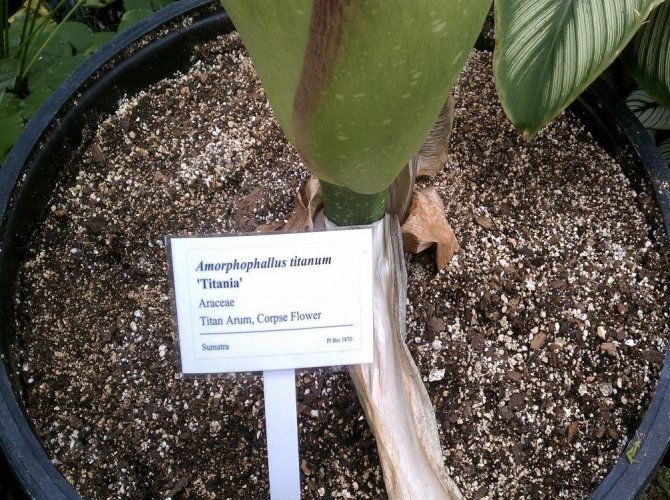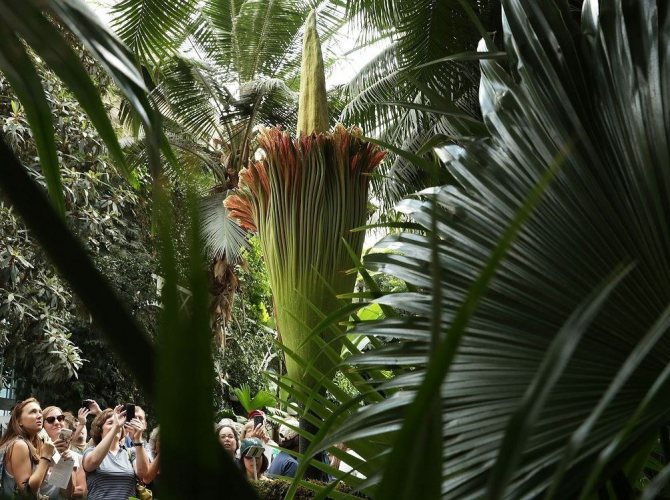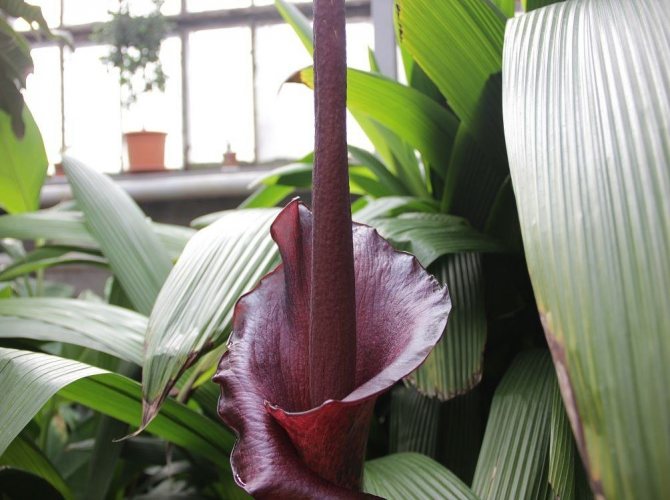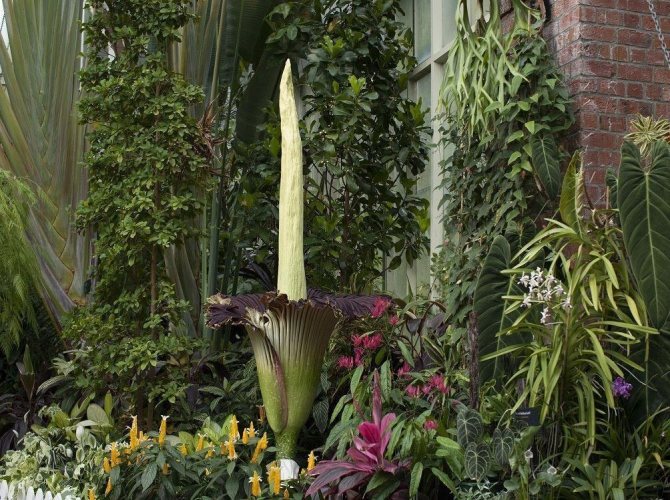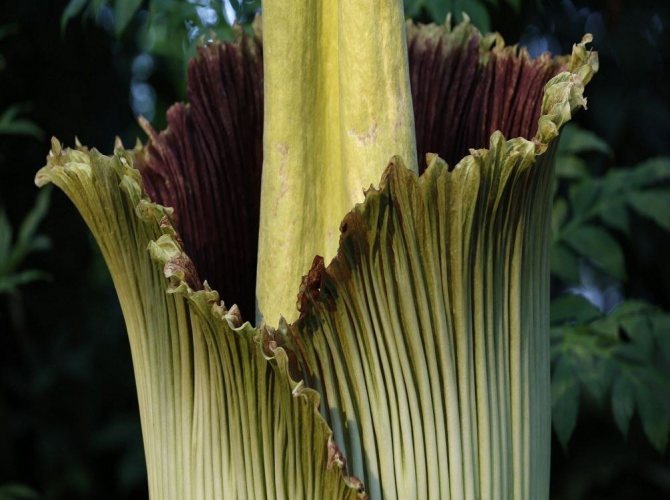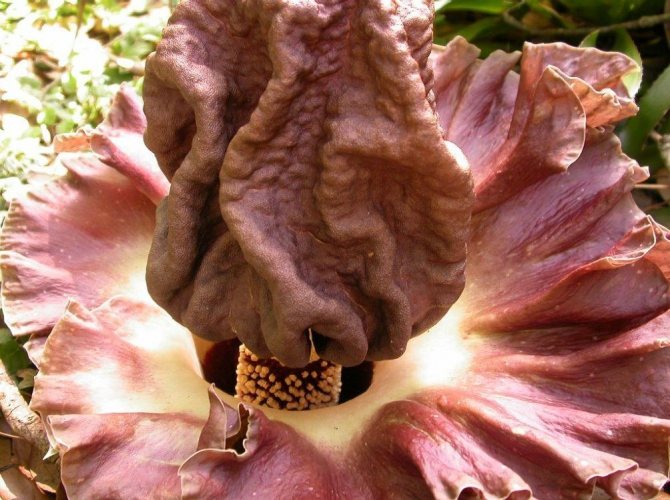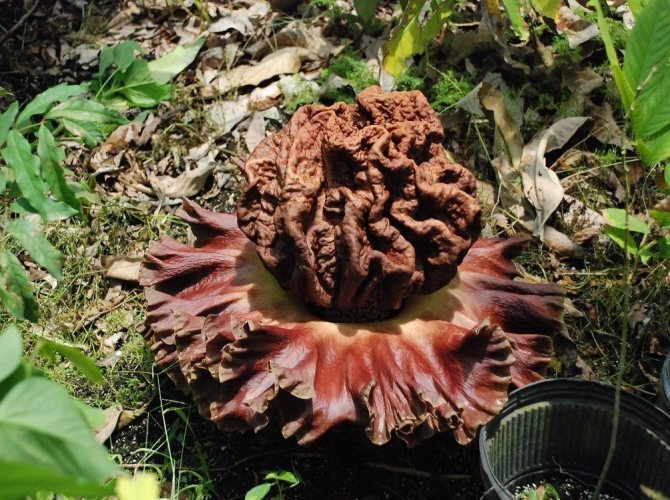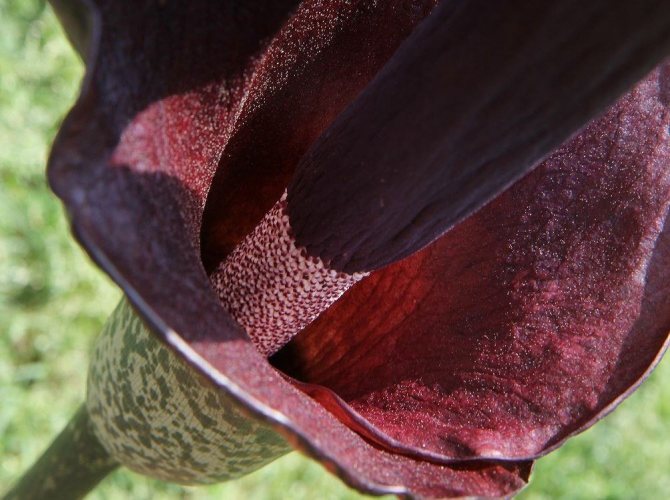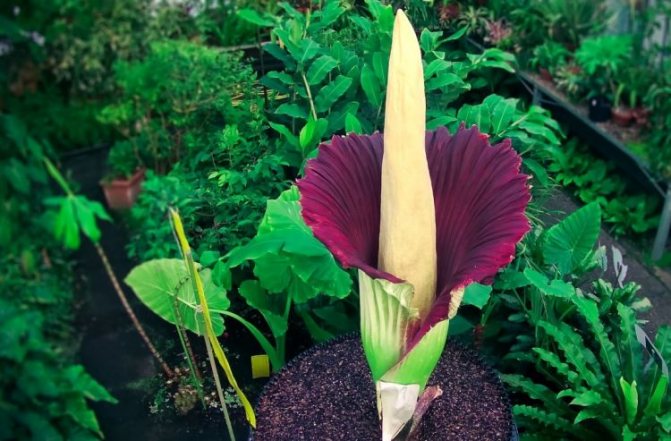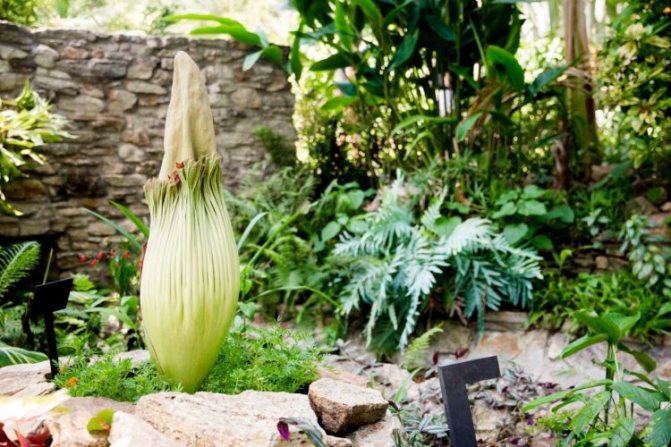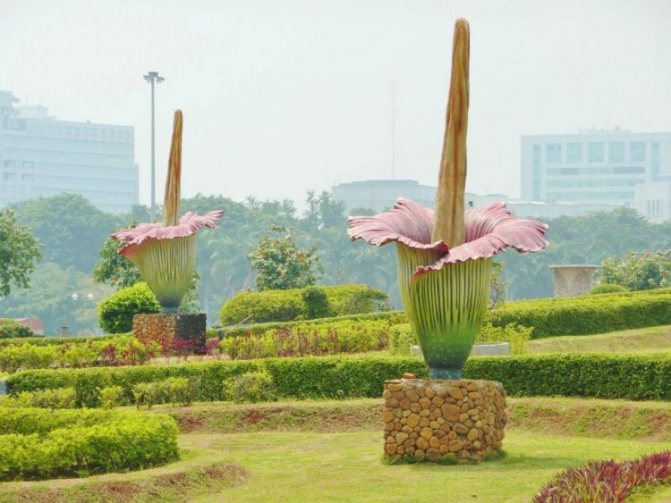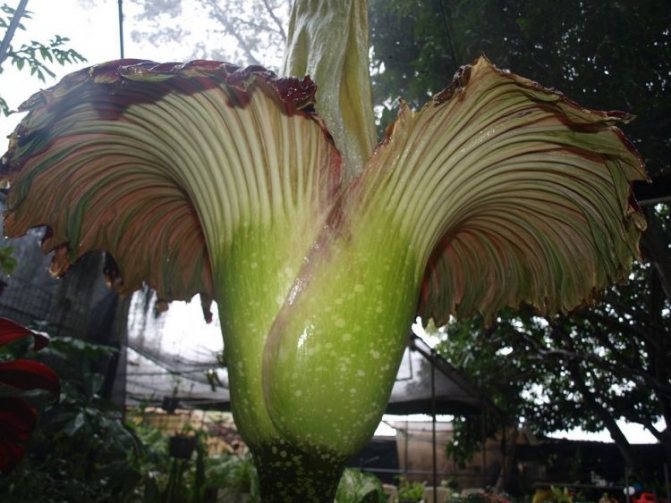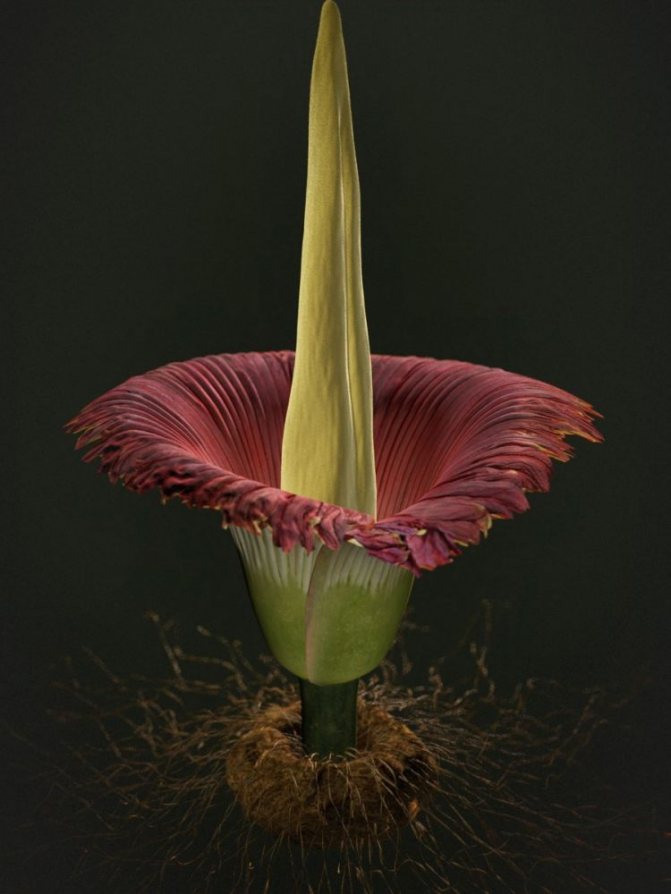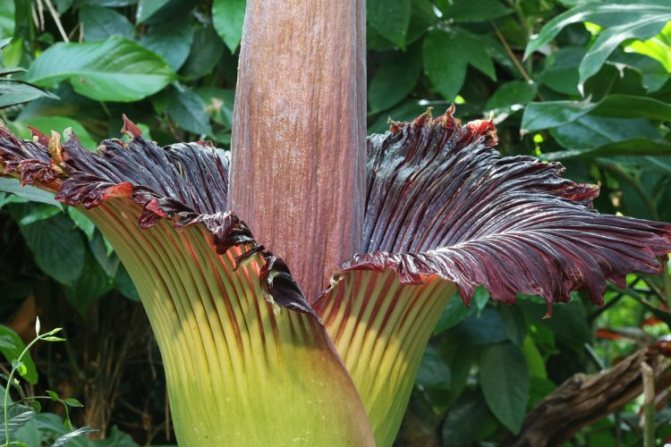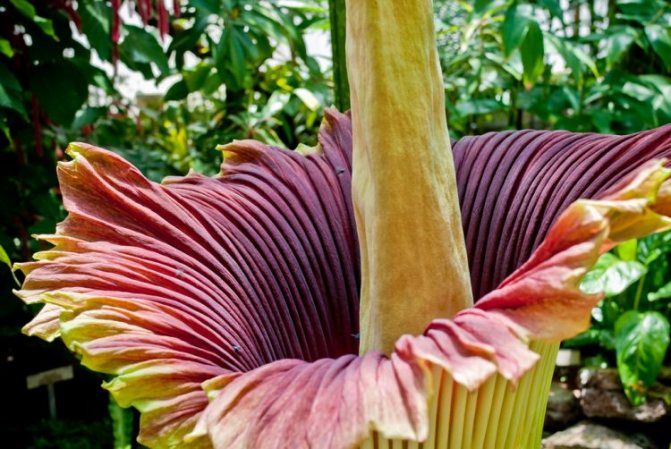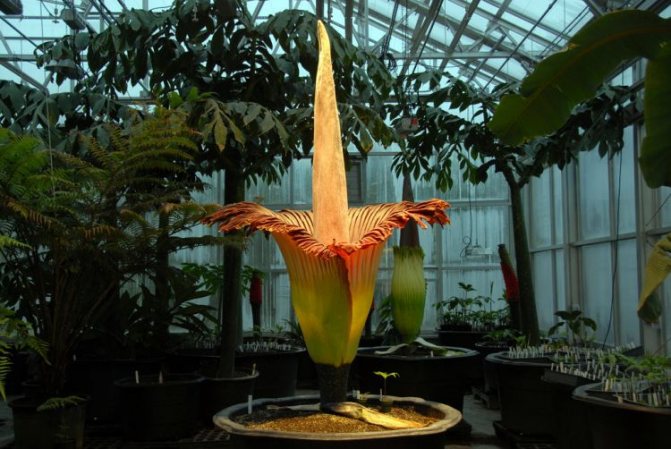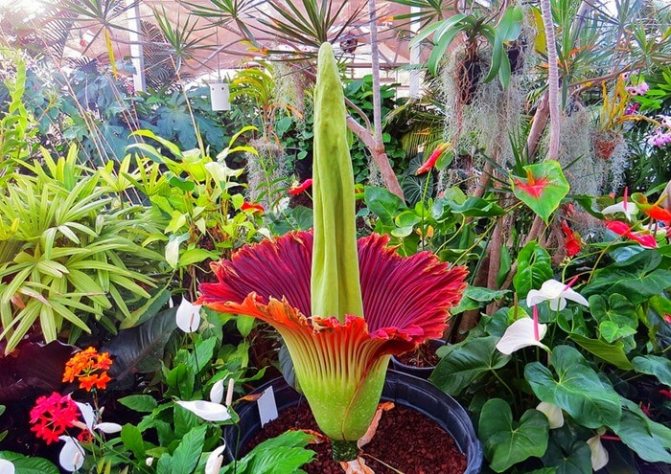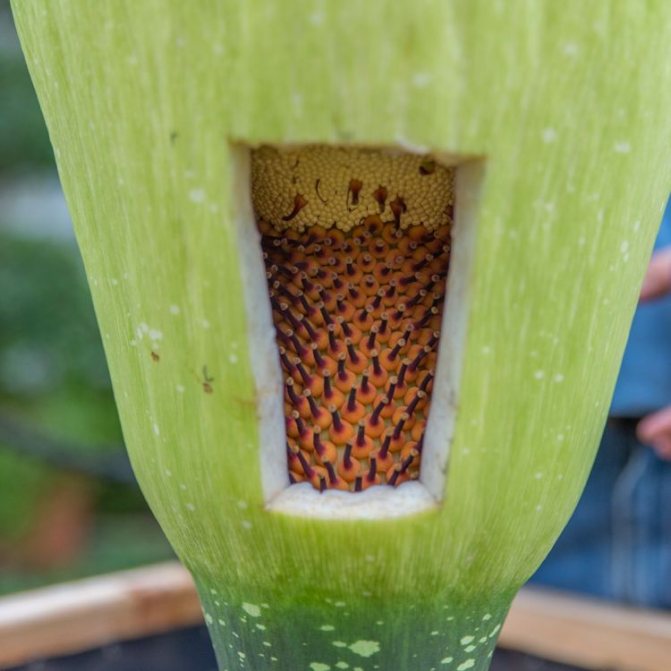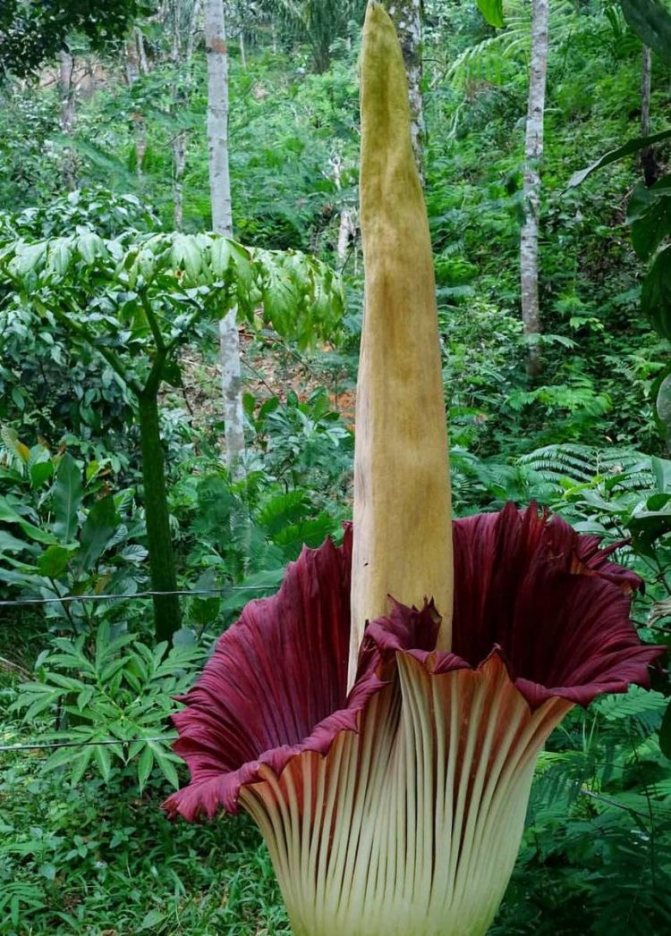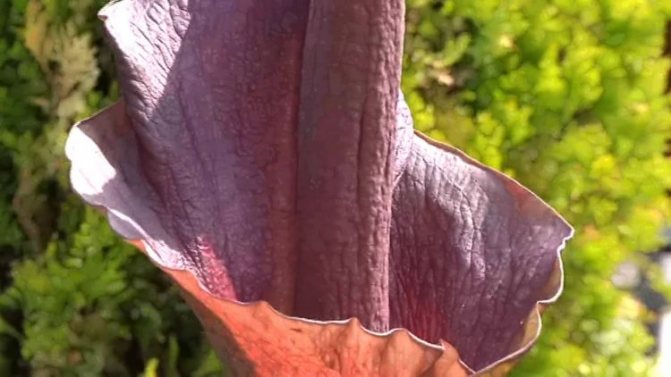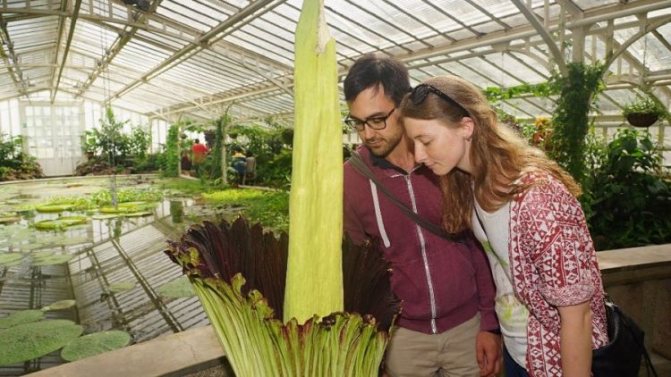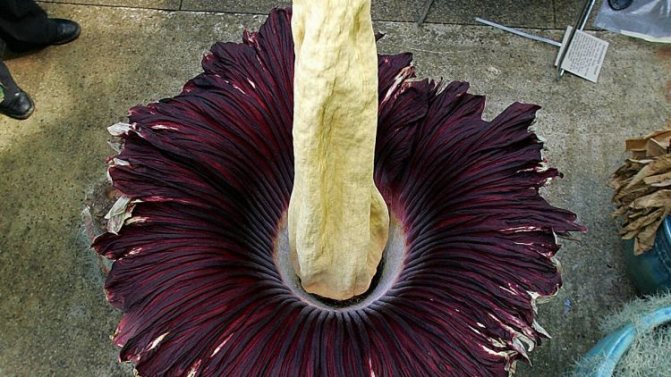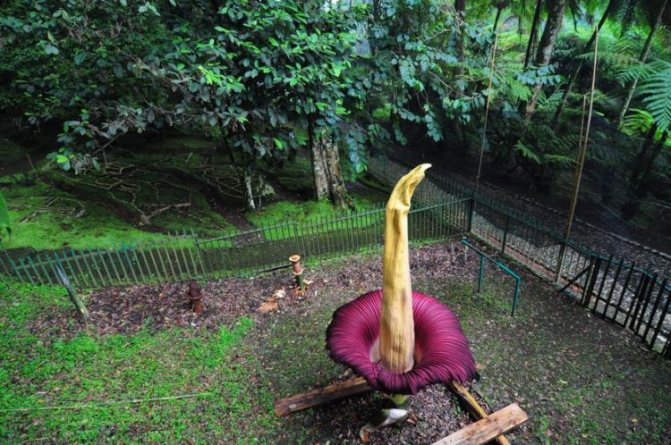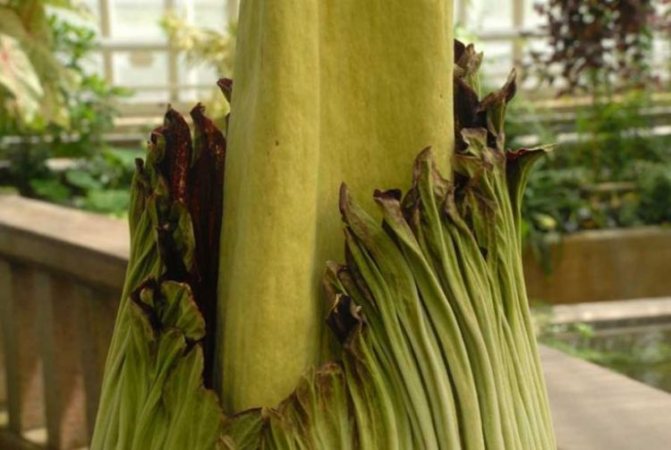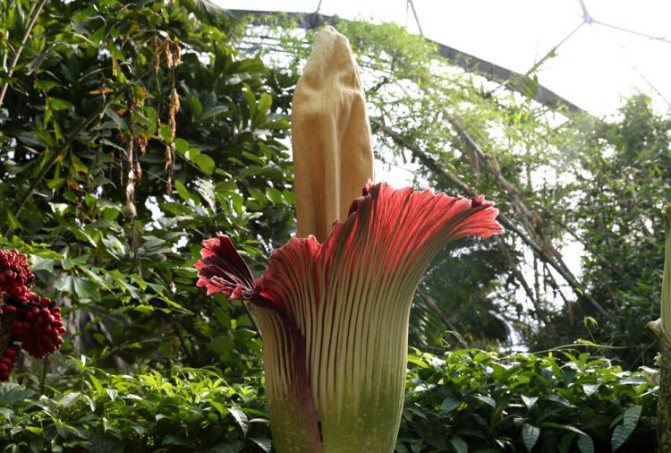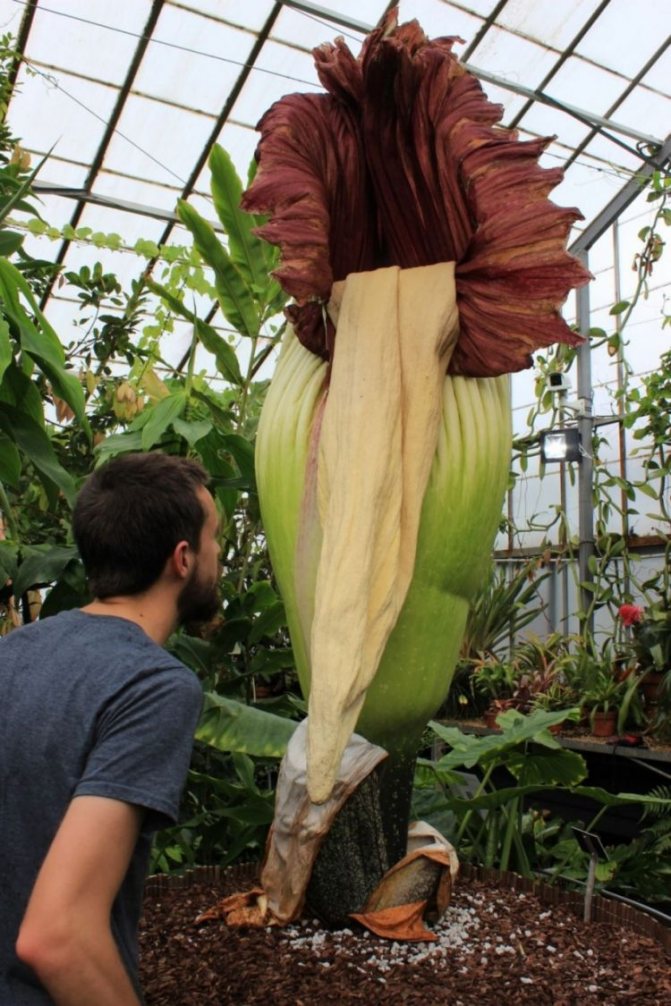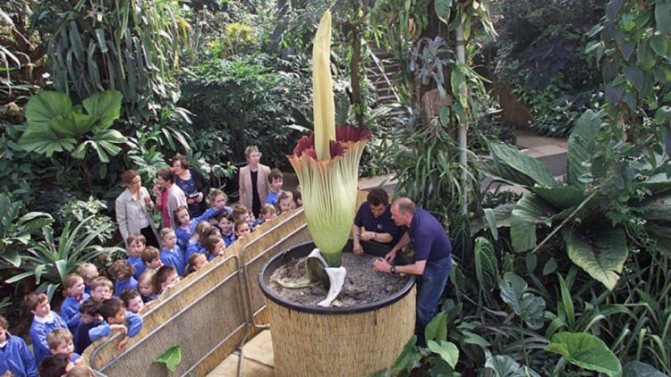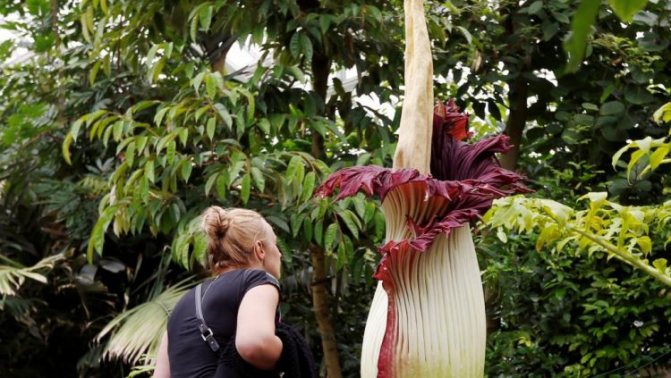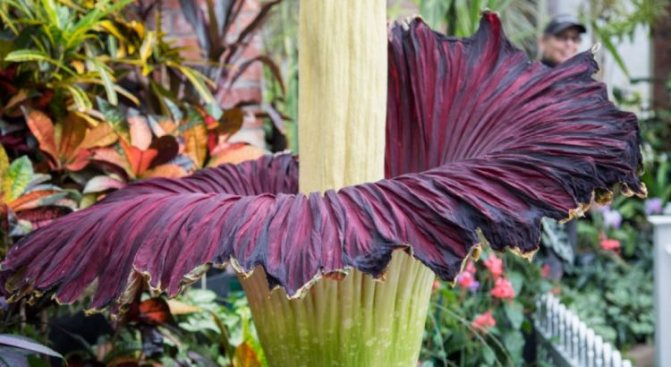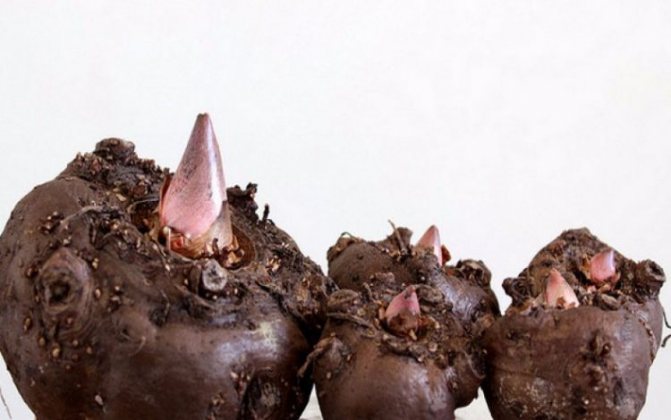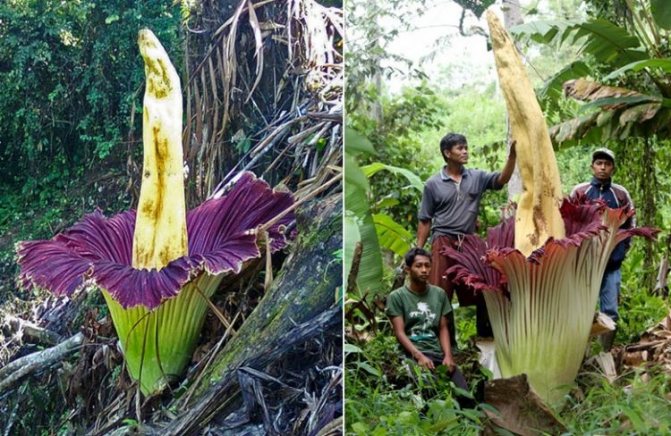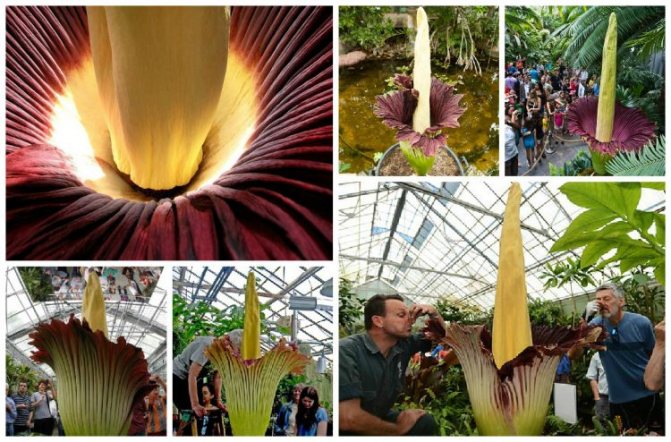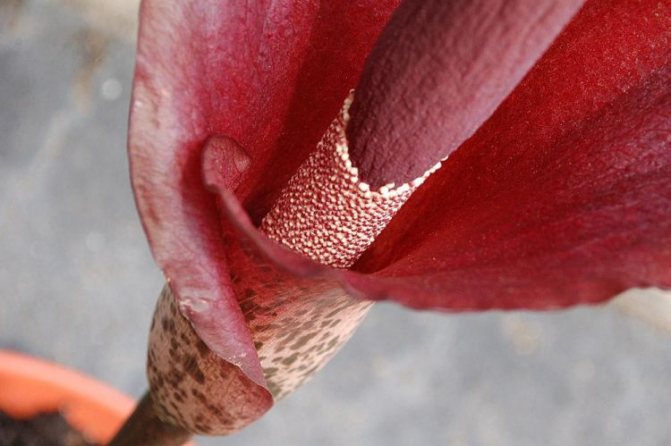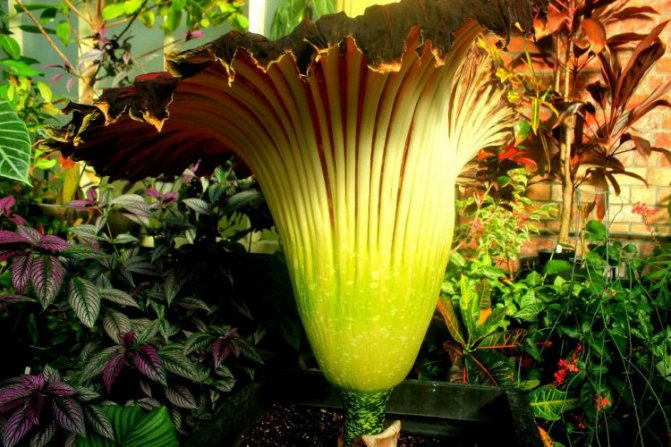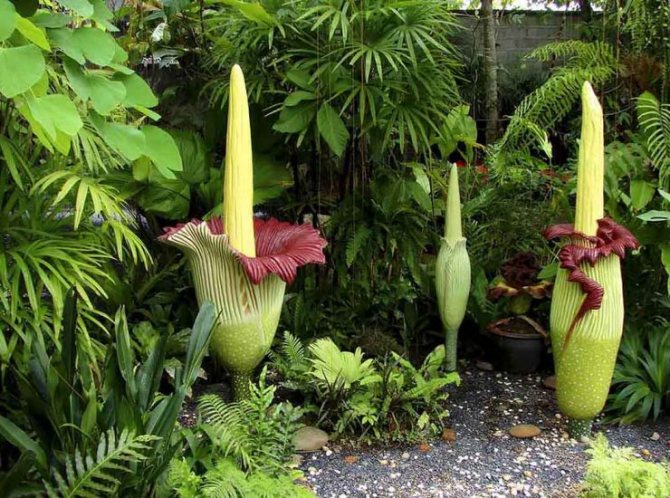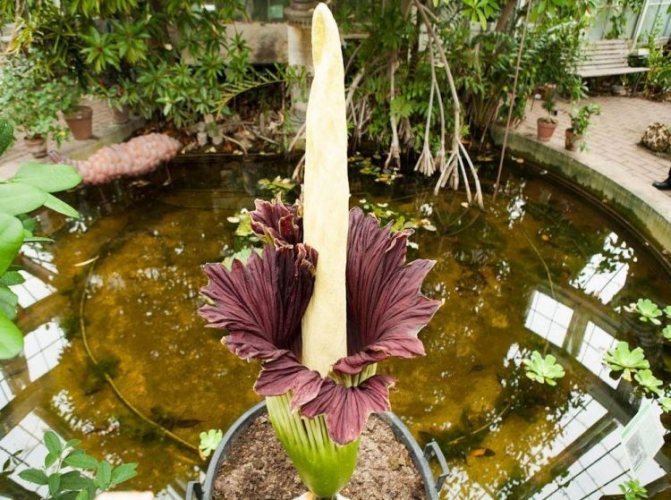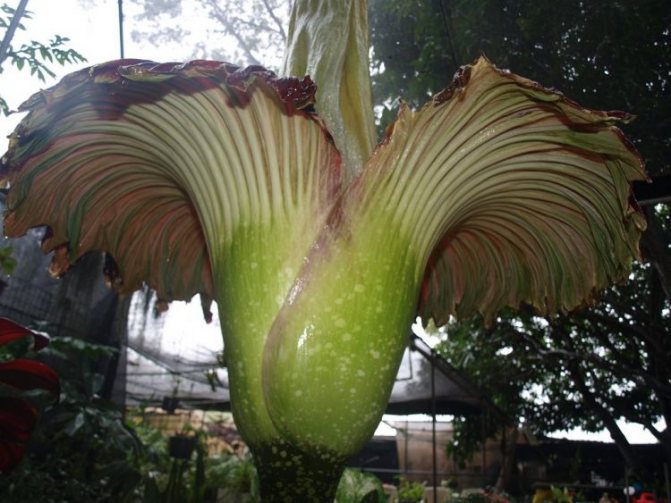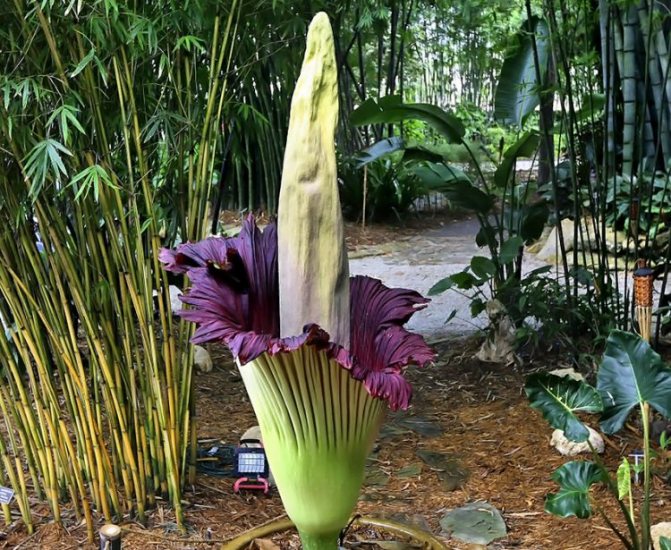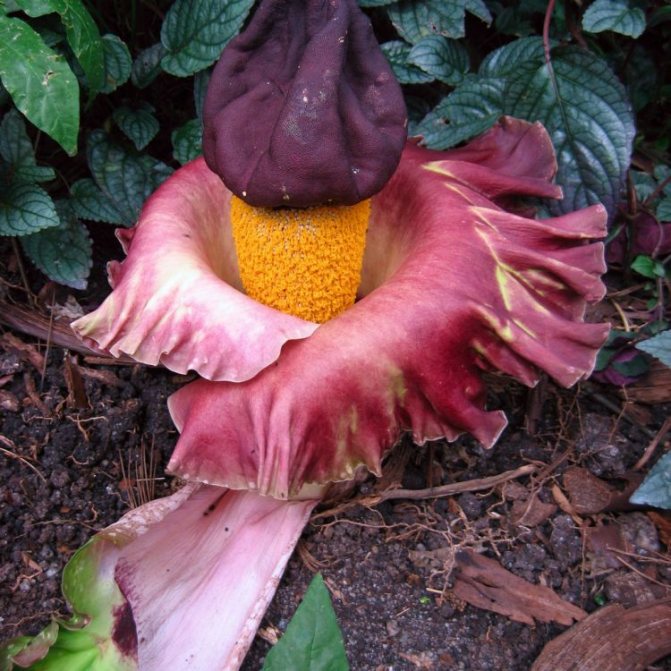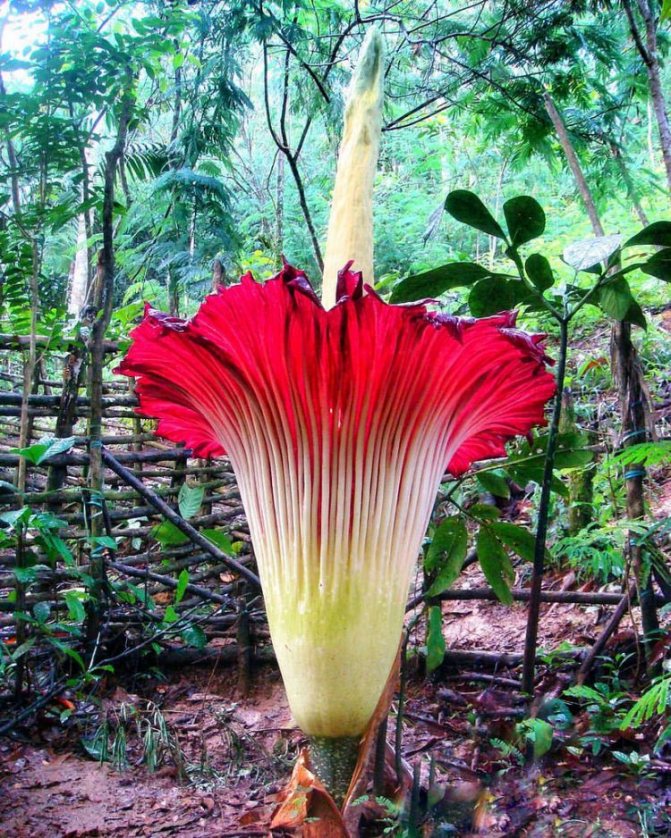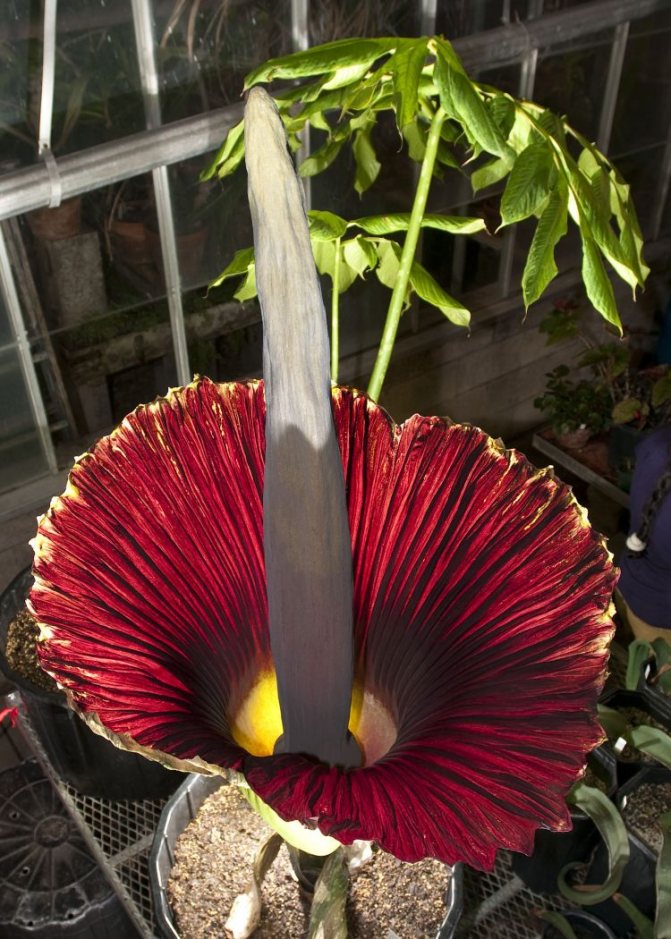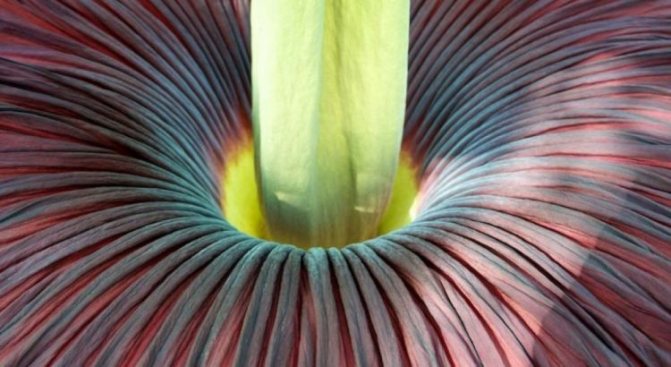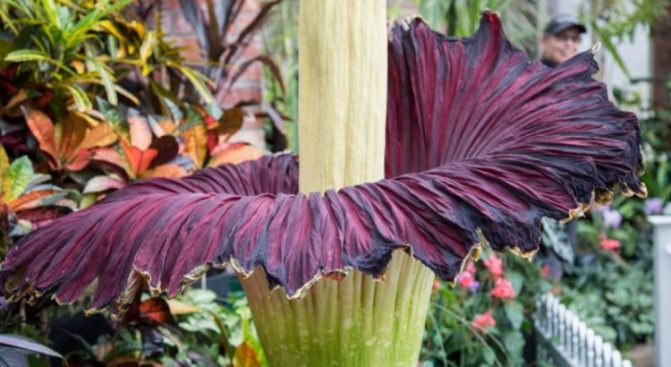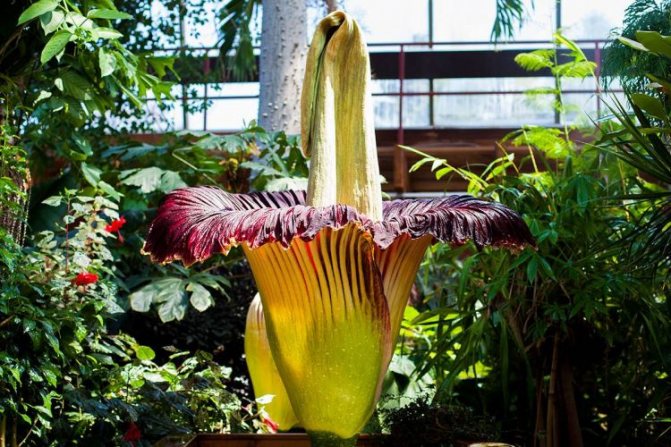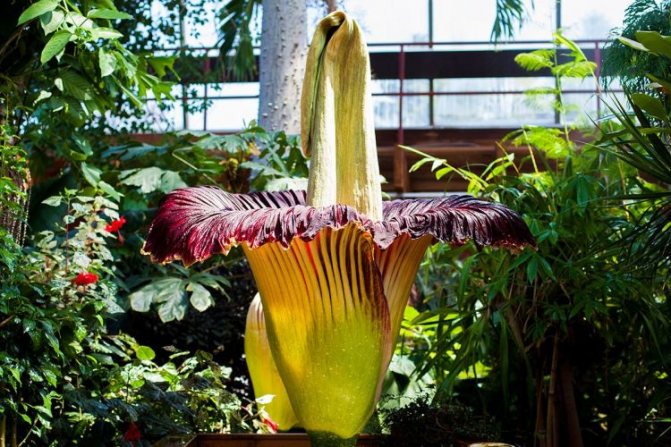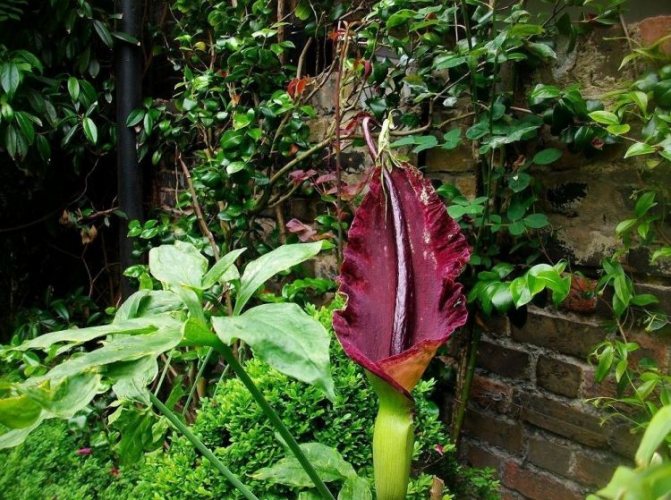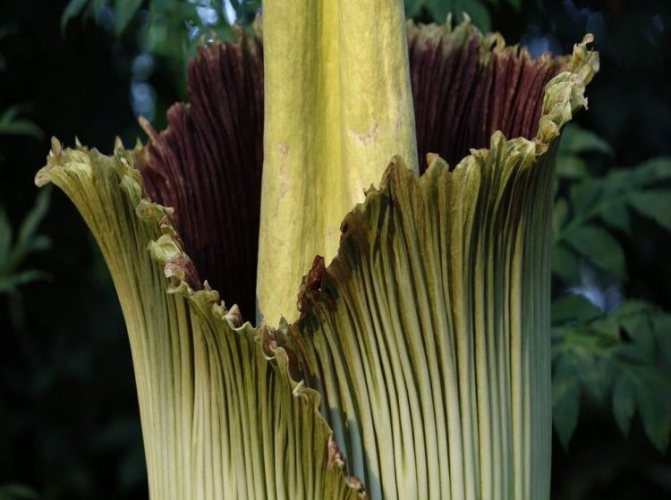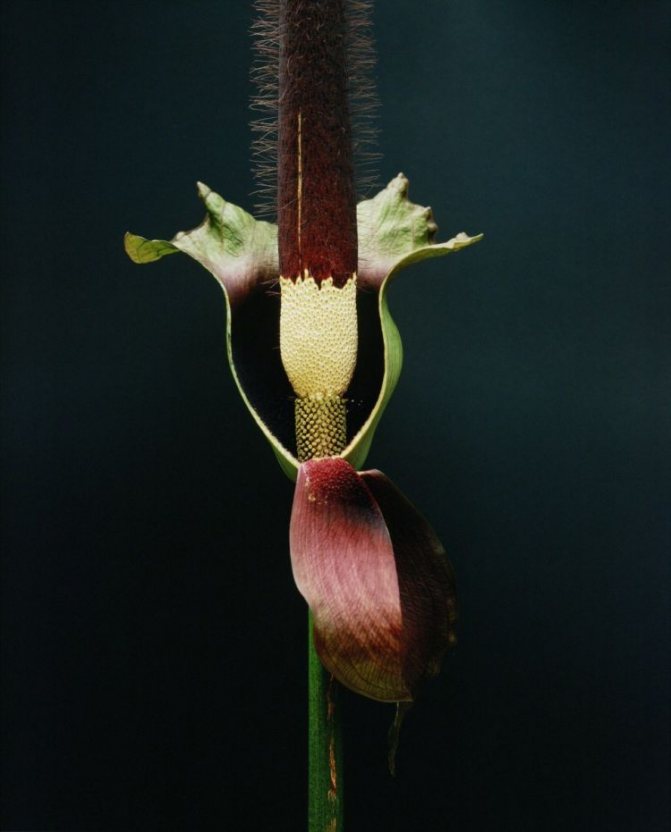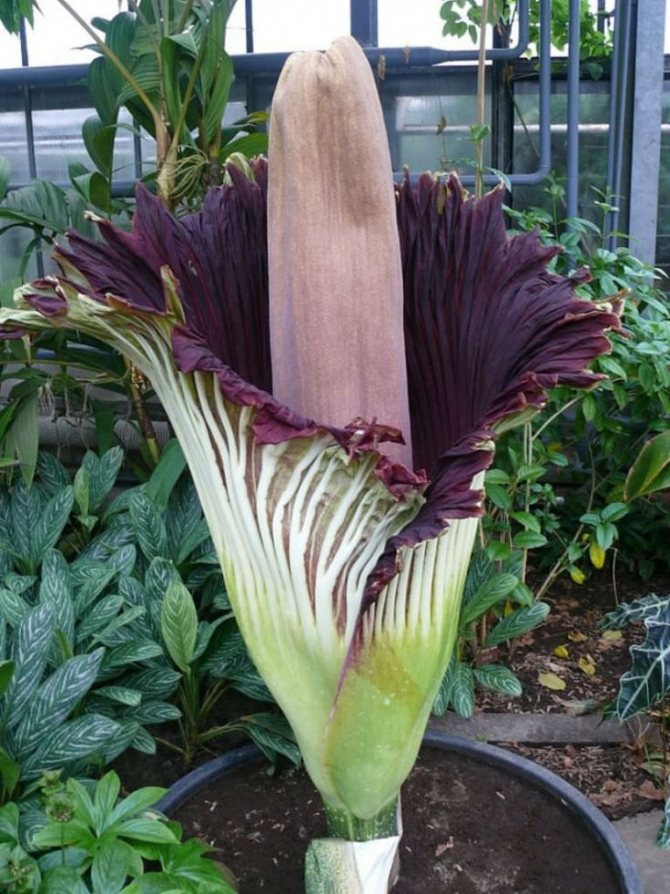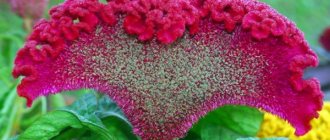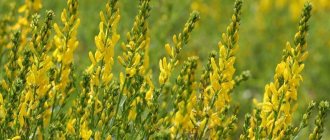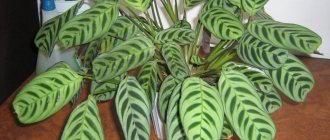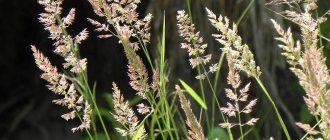Deciduous plant amorphophallus (Amorphophallus) belongs to the aroid family (Araceae). It comes from Indochina. The name of this genus consists of Greek words, so "Amorpho" means "formless" and "Phallus" - "offspring, escape". The plant was so named because of the appearance of the cob inflorescence.
This plant is ephemeroid (short-lived). So, his dormant period differs in its duration, and it lasts more than six months. In the ground, he grows a tuber, which is similar in size to a grapefruit, and it weighs about 5 kilograms. A green, rather thick stem, similar in appearance to a palm trunk, grows from just such a tuber. Only one complex half-meter leaf plate grows on the trunk. It is tinted greenish brown with whitish dots on its surface. The leaf is tripartite and twice pinnately dissected. There is a hollow petiole.
The lifespan of such a leaf plate is only a few months. So, it grows, as a rule, in the last weeks of March, and in mid-October it turns yellow and dies off. Each subsequent year, the leaf grows slightly higher and becomes more and more dissected.
The development of a flower occurs after the end of the dormant period and before a new leaf grows. The plant blooms for about half a month, but even before new roots grow, it will stop. During the flowering period, the size of the tuber becomes much smaller. And all because a large amount of nutrients are consumed for the growth and development of a flower, which are taken from the tuber. In this regard, after the plant has faded, it will again have a short dormant period (about 3-4 weeks). After it ends, the leaf plate will begin to grow. It happens that the dormant period after flowering lasts almost a year (until next spring). In the event that the flower has been pollinated, then after the flowering is over, the seed will begin to grow, consisting of fleshy berries, in which the seeds are located. In this case, in the case of fruit development, the mother plant dies. This plant is also called "cadaveric flower". This is because it has a unique scent that is very similar to that of a decomposed mouse carcass or rotten fish. However, such an aroma does not emanate from him too long, only 1 or 2 days. Thus, the plant notifies pollinating insects that the flower has opened. Male flowers, as a rule, open a little later than female flowers, in this regard, the plant rarely self-pollinates. For pollination, it is necessary that at least 2 plants begin to bloom at the same time.
From the history of appearance
It is not known for certain who first came up with the idea of breeding the largest flower in the world, amorphophallus, as an indoor flower. Today, many amateurs grow it in artificial conditions. Many are scared off by the stench that this unique plant exudes.
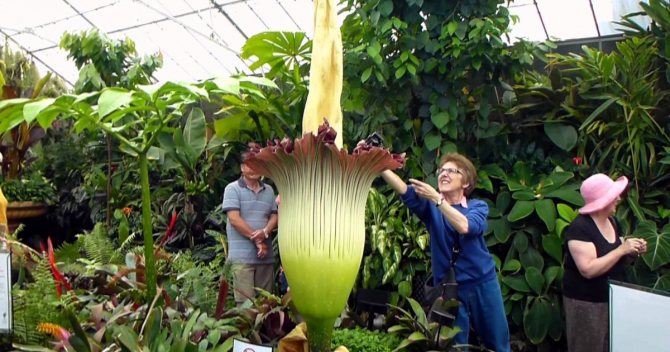
Amorphophallus is a giant flower that strikes everyone
It should be noted that the unpleasant smell appears only when you touch the flower.
How is the flowering period
Amorphophallus giant is classified as an ephemeroid, since its flower blooms for only a few days, and blooms once every ten years.The inflorescence is a large yellow ear with a veil-like leaf wrapped around it. The inside of the leaf is burgundy, the outside is pale green. The ear, like the trunk, is strewn with dark green spots. Its height can reach 2.5 m, and the diameter of the sheet-bedspread is from 1 to 3 m. For the unusual structure of the flower, the people call it "voodoo lily".
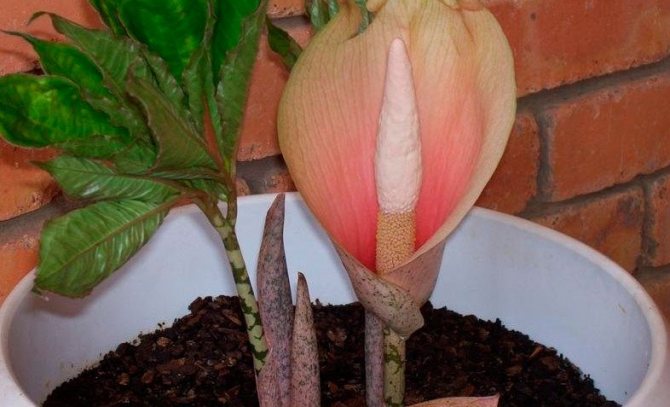

The smell that emanates from amorphophallus at the time of flowering resembles semi-decomposed meat or fish. Therefore, another name for the plant is "cadaveric flower". If the plant develops correctly, then in 7-10 years the amorphophallus will delight you with flowering. If a tuber has reached a weight of 9 kg, then after a dormant period, it throws out a flower arrow with an ear.
After a while, female flowers bloom on the cob, and the next night, male flowers. The intense scent is intended to attract the attention of pollinating insects. If pollination has occurred, then the seed fruit begins to develop, consisting of red fleshy berries. Fruit development lasts 8-9 months. After the fruit grows, the maternal tuber dies. But you can always plant the resulting seeds and start the cycle again.
Did you know? To pronounce the Latin name for amorphophallus without blushing, David Attenborough, an English naturalist and host of the BBC plant series The Private Lives of Plants, coined the name Titan arum. Arum is an arum, a typical member of the Aroid family. From the BBC's point of view, such a name sounds less scandalous.
What does it look like
There are few people who dare to plant an amorphophallus flower in their home. This is probably due to the fact that few people are attracted by the "aroma" of decaying flesh in living quarters. Because of the smell, amorphophallus is rarely grown as a houseplant.
The flower belongs to the Aroid family, although many mistakenly believe that it is a special type of lily.
Interesting. Unlike most other plants, the amorphophallus palm does not have dormancy periods.
The name of the flower is translated as "shapeless offspring." He also has one more name - a snake palm or a snake tree. It got its flower due to the similarity of its trunk with the skin of a reptile.
At the same time, the flower is not quite a flower, but a single petal of the original shape, which is covered with numerous specks. It surrounds the ear, the shape of which can vary significantly depending on the particular plant variety.
conclusions
- Amorphophallus, or snake palm, is a deciduous plant of an ephemeroid type. Has a long dormant period, dies immediately after flowering.
- The flower is decorative and has an unpleasant smell, reminiscent of rotten meat. Flowering can last up to 30 days.
- Compliance with the rules of cultivation and care allows you to maintain the health of tubers, to achieve budding.
- The basic rules of care are abundant watering during the flowering period, top dressing only during the growing season, regular transplantation or soil replacement.
Common types
The giant flower has many varieties. The main ones include the following.
Amorphophallus titanic
Amorphophallus titanum (amorphophallus titanum) is a fairly tall and very large flower. Its tuber, which looks a bit like a potato, can reach 20 kg by weight. The ear of this plant species can grow up to two meters in height and has a burgundy fleshy inflorescence.
Among flower growers, amorphophallus Titanium is a fairly common species, but keeping it at home will not work because the plant is too large.
Curious. There are many interesting facts about amorphophallus titanic. For example, in Asian countries, this stinking plant is used for food. It is often used to add to soup.The tubers are used to make flour for the noodles. In this regard, in many Asian countries, it is called elephant bread.
Amorphophallus Cognac
The flower amorphophallus konjac is otherwise called amorphophallus pion-leaved. It has a relatively modest size, flattened tubers. The latter are about 20 cm in diameter. The length of the peduncle is about 60 cm, the cob is 50 cm. The inflorescence has a violet-burgundy hue.
The Cognac variety has more compact dimensions.
Amorphophallus bulbiferous
Bulbous, or bulbous amorphophallus is most suitable for the role of a houseplant, since it is particularly compact in size. The adult flower continues to grow to only half a meter in length. This species is characterized by a pale pink color and an inflorescence not higher than 30 cm in height.
Amorphophallus Rivera
Another variety that can be grown as a home plant is Rivera. It grows up to 1 meter. But this amorphophallus flower blooms much more often when planted at home. Truth never bears fruit.
Amorphophallus care during growth
Caring for a giant flower is considered a moderate occupation. The plant requires time and attention, but is ready to pay generously with its incredible appearance for the minutes and hours given by the owner. Well-groomed amorphophallus blooms only once a year. Flowering lasts about 14 days.
The Japanese believe that Voodoo lily tubers help cleanse the digestive tract and are a must eat product in the fight against excess weight. That is why what others are used to admiring, the inhabitants of the Land of the Rising Sun use to prepare various traditional dishes - from noodles to tofu cheese.
Where to put the pot
The story of how to care for amorphophallus after purchase begins with placing the pot in the right place. It should be placed where there is really a lot of light: in the living room not far from the window, on the veranda, in a bright dining room or loggia, which is insulated. The tropical visitor adores bright light, but in summer it is intolerant of direct sunlight.
Loves warmth or cold
Reviews about growing a snake palm tree in an apartment indicate that a capricious amorphophallus requires different temperature conditions depending on the season. In a hot period, when there is summer heat outside the window, the optimal temperature for a handsome man will be in the range from 20 ° C to 25 ° C. And during hibernation, a representative of the tropics prefers cold: in winter, 12-13 ° C is considered the ideal temperature for amorphophallus.
Humidity level
A tropical plant, even in our latitudes, remains tropical. The devil's tongue loves high air humidity, and in summer it is always happy to be sprayed with a spray bottle. Therefore, in tandem with an air conditioner that is constantly functioning during the hot season, the owner of the amorphophallus should use a household humidifier. Low importance is the main reason why amorphophallus does not bloom at home.
Watering frequency
Answering the question of how to care for amorphophallus, one cannot but touch upon the problem of watering. This plant needs moisture only in the growth phase. The watering algorithm is as follows:
- We take purified water.
- Pour into a pot, as if drawing a circle along the edge of the ground.
- Check if the tray is filled with water.
- We leave the flower for 40-60 minutes.
- We pour out the rest of the water from the pan, being sure that the moisture is evenly distributed over the substrate.
Watering the plant in the summer should be frequent and abundant. Notice that the topsoil is dry? Carry a watering can.
Pest control
The main character of the article is a persistent and strong flower. This tropical inhabitant is not afraid of pests or diseases that other green pets are afraid of. The only one who can harm the amorphophallus is a spider mite. But proper care of the plant will protect it from the appearance of this problem.A spider mite is afraid of high humidity, and therefore, with a well-groomed amorphophallus, it is usually not on the way.
The snake palm is a home barometer. If the weather decides to worsen, the plant will feel it and will release well-visible drops on the tips of the leaves.
Feeding rules
Top dressing is good when it is competent. Fertilize amorphophallus only after the leaf opens up to 100%. If you start feeding earlier, nothing bad will happen, but you should not count on the miraculous effect of fertilizers. At the moment of full disclosure of the leaf, the root system of the plant is already sufficiently developed and ready to assimilate useful substances. But before opening the leaf, she is not yet able to assimilate the usefulness. Fertilizers with a high phosphorus content are considered ideal for feeding amorphophallus. Its amount should be four times higher than the content of other chemical elements.
A gardener caring for a Voodoo lily should have both organic and mineral fertilizers in his arsenal. Experts advise using them alternating with each other from early spring to late summer.
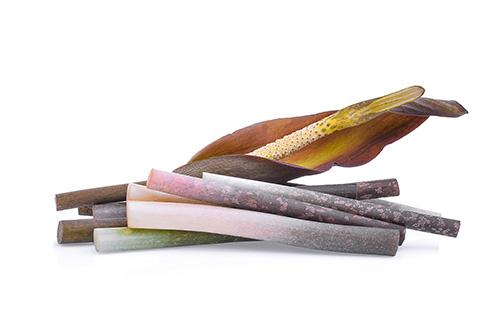

Care features
Like any other plant, the indoor snake tree requires some care.
Temperature
In the summer, the flower will feel great at room temperature. In winter, it is recommended to keep the plant cool from +10 to +13 degrees.
Lighting
The world's largest flower, amorphophallus, needs good lighting. Light must be diffused without fail.
Watering
During the period of intensive growth, amorphophallus requires quite abundant watering. In this case, do not allow water to enter the tubers. After the leaves begin to turn yellow and die off, the number of watering needs to be reduced.
Spraying
The plant requires periodic spraying. It should be performed at least once a week.
Humidity
Amorphophallus is hygrophilous. When growing a plant, this factor must be taken into account without fail. Low humidity is the main reason a crop may stop blooming.
Priming
The soil for planting should be neutral or have a weak alkaline reaction. You can prepare the soil mixture yourself from the following components:
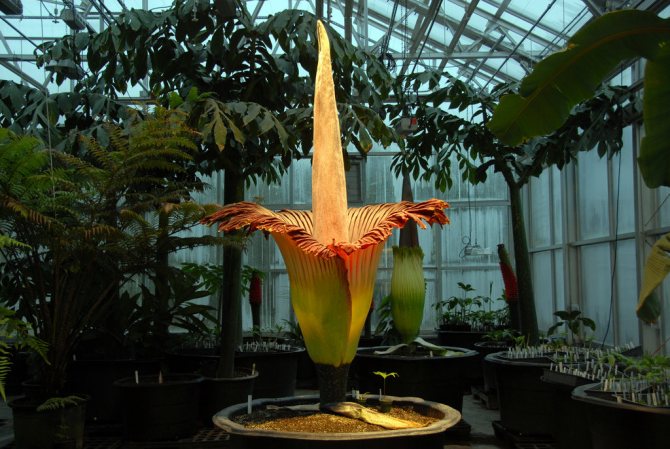

Most often, people who are passionate about it are engaged in the cultivation of a flower.
In addition to the above, it is recommended to add a small amount of pieces of pine bark or charcoal.
Top dressing
You should start feeding the flower only after the leaves have fully opened. If you do this earlier, fertilization simply will not work - the flower simply will not absorb nutrients. Formulations with a high phosphorus content are suitable for feeding. The application of mineral fertilizers should be alternated with organic ones.
Conditions of detention
Amorphophallus is moderately unpretentious when grown in an apartment. However, the plant is able to develop and bloom only in comfortable conditions. If the requirements for humidity, illumination and soil composition are not met, early leaf fall, slow growth of vegetative parts are observed.
Lighting and location selection
The palm tree is demanding on the quality and duration of lighting. For development, you need constant and bright diffused light from 10 hours a day. It is advisable to place a pot with a flower on the east or south side of the house. Darkening is recommended at midday to avoid burns on the leaves. For the winter, the container with a dead flower should be removed to a dark place.
Temperature
Amorphophallus has a distinct growing season and dormancy. Throughout its growth, the plant needs stable heat in the range of 20 to 25 oC; at lower temperatures, the flower does not form.During rest, the heat must be lowered to 9-12 oC; the beginning of the transition to this stage can be determined by the blackening of the foliar part.
Humidity
The increased humidity of the air and soil is a key factor in the harmonious development of the flower. It is important to observe the watering regime throughout the growing season, avoiding the drying out of the substrate. During rest, it is enough to water the soil a little to avoid drying out. The plant does not tolerate water procedures, you should not take a shower. To maintain soil moisture, it is recommended to install a container with water or wet pebbles next to it.
Soil and pot
To grow amorphophallus in an apartment, you can use any ready-made mixture for palm trees. If you plan to prepare the substrate yourself, then it is enough to mix leafy soil, peat, sand and sphagnum moss (sawdust) in a ratio of 2: 2: 1: 1. The soil should be light and loose throughout the entire period of active growth.
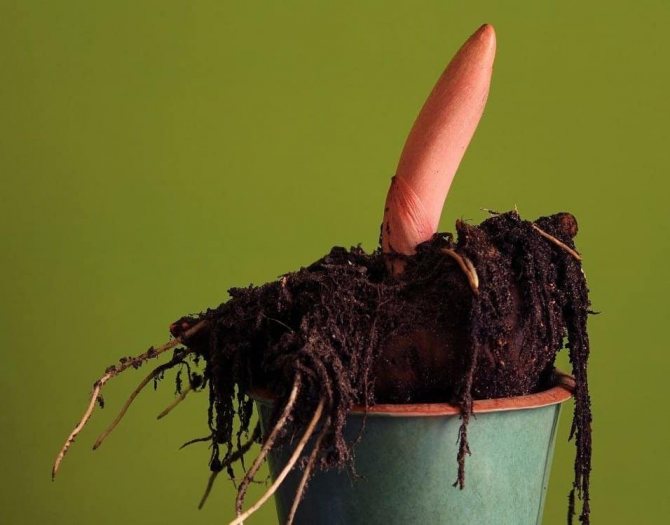

The container for the plant should be voluminous and free, corresponding to the size of the root system. Experienced florists recommend choosing pots made of plastic or ceramics with a diameter of 12 cm or more.The material of manufacture should be light, which avoids overheating during active exposure to the sun.
When and how it blooms
Amorphophallus is an amazing plant that is especially prized for its flowers.
Types of flowers
The flowers of the snake palm are monoecious, without a perianth. They are divided into male and female.
Flower shape
The inflorescence has an oval or elongated (depending on the variety) ear and cover. The latter is either falling or non-falling, divided into a tube and a plate. The tube is cylindrical or bell-shaped, smooth inside or corrugated. The cover plate can also look different, depending on the specific plant variety taken.
Flowering period
A complete description of the culture will not be complete if you do not tell about the period of its flowering.
At home, amorphophallus blooms for one to two months in the summer with an interval of three years. The flower remains open for a week. Flowering takes a lot of energy from the plant. After its completion, even its underground tubers are significantly reduced in size.
Important! Young plants begin to bloom from the age of five.
Changes in flowering care
Caring for a palm tree during the flowering period is the same as on other days. Don't touch this amazing flower. Otherwise, the very next moment you will have to cry because of the intolerable stench. The structure of the flower is such that touching it causes an instant increase in the temperature of the plant up to +40 degrees. It is the temperature that leads to a serious increase in odor.
Botanical description
Amorphophallus is a perennial tuberous plant. Its height depends on the species and can range from 80 cm to 5 m. There are both evergreen varieties and plants with a dormant period. The rounded tuber is covered with wrinkled skin. Its weight averages 5-8 kg, but there are also heavier specimens.
A petiole leaf opens from the top of the tuber. Most often it is one, but up to 3 pieces can appear. Smooth or rough petiole is very thick and strong. The leaf lives for only one year. It appears after the flower dies off. The dark green leaf is covered with a mesh pattern of veins. Every year, the leaves become taller and larger, and the leaf plate acquires a more dissected shape. Gradually, the foliage reaches several meters in diameter.
After a dormant period, the flower appears first. It is more correct to call it an inflorescence. An elongated, irregular ear is partially hidden under a huge blanket. It is held by a short but thick pedicel. The pleated bedspread rolls up into an oval tube or falls partially. Amorphophallus are monoecious plants.On the inflorescence are male and female flowers, separated from each other by a sterile space.
During the flowering period, the amorphophallus flower exudes a very unpleasant, and sometimes just disgusting, smell. One has only to touch it, the aroma increases, and the temperature of the plant rises to 40 ° C. Scientists analyzed the smell and found chemical compounds in it that are characteristic of the following items:
- aromatic cheeses (dimethyl trisulfide);
- excrement (indole);
- rotting fish (dimethyl disulfide);
- luscious sweetness (benzyl alcohol);
- smelly socks (isovaleric acid).
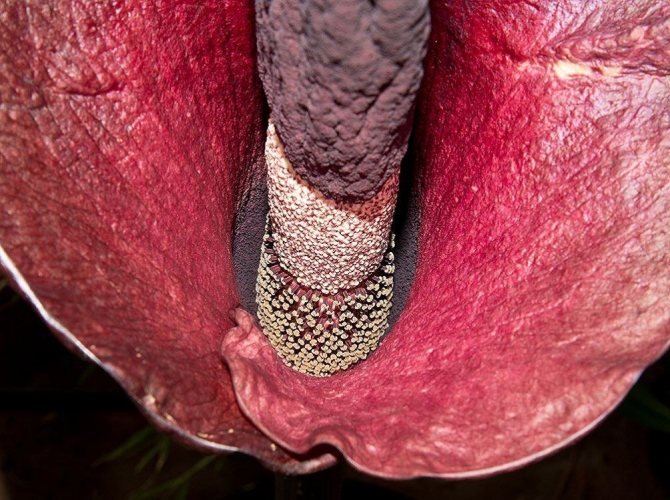

This specific scent attracts flies, moths and other insects involved in pollination of the plant. As a result, fruits are formed on the cob - miniature juicy berries with a thin skin. They are colored white-pink, red, orange or blue. Inside are one or more oval seeds.
Breeding features
Reproduction of amorphophallus is possible in various ways.
Germinating seeds
Palm trees are rarely grown from seeds, since this is a very laborious and long-lasting process. And the plant will be able to bloom no earlier than in five years. If such a desire still arises, a step-by-step recipe for germinating seeds will look something like this:
- Soak the seeds for a couple of days.
- Mix garden soil, peat and vermiculite.
- Place the seeds in the soil mixture to a depth of 7 to 12 mm.
- Place the container with seeds in a warm and well-lit place.
Seedlings can be expected on average in ten days, in another week the seedlings will give the first leaf.
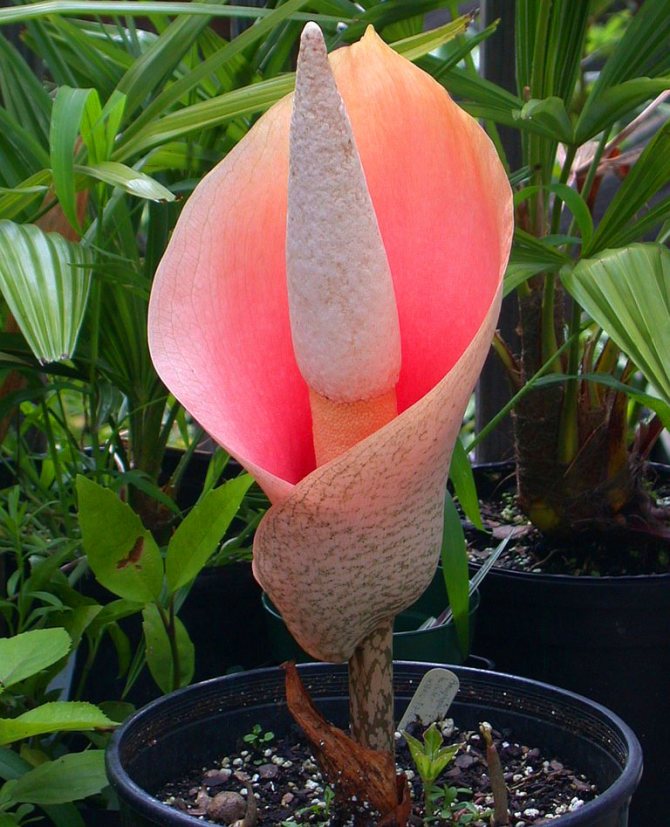

The bulbous variety is often grown in artificial conditions.
You should not rush to transplant the sprouted sprouts into separate containers, many of them will die as they grow.
Rooting cuttings
The plant is not propagated by rooting cuttings.
Dividing the bulb
An adult bulb, on which there are several buds, is divided into parts. The procedure should be performed in early spring, after small shoots appear on the buds. The incisions must be done very carefully to avoid kidney damage. Places of cuts must be treated with crushed charcoal, the tubers themselves should be dried a little in the air. After about a day, the planting material can be placed in the ground.
Spring awakening
With the arrival of spring, the tuber must be removed from the cache and inspected for an increase in the growth point. If the tuber has begun to develop, then it's time to plant the Voodoo lily in the ground. When interested in how to transplant amorphophallus, pay special attention to the diameter of the tub: it should be three times larger than the diameter of the planted tuber.
In the wild, the plant chooses soil saturated with limestone. You can please the "domesticated" amorphophallus by offering it a soil with the following composition:
- sand;
- leafy soil;
- humus;
- peat;
- turf.
The fourth part of the voodoo lily pot needs to be covered with drainage. Do not discard any residual soil. During the entire period of growth, the soil will have to be poured into the pot. From the moment of planting, you need to begin to water the amorphophallus palm abundantly, remembering that high-quality watering and suitable humidity are the key to the full development of this representative of the tropical flora.
Babies can form on the maternal tuber. Having found them, you should fill up the soil and thus close them. Small "tubers" should never be exposed.
Surprisingly, the snake palm tree easily reproduces in the conditions of an ordinary city apartment. Knowing how to care for amorphophallus and having mastered the simple skills of watering and transplanting, by the end of the flowering period you can become a happy "parent" of several tubers at once. In addition, the flower, satisfied with the care, generously gives seeds. For reproduction of a snake palm, you need to correctly extract the seeds from ripe berries and plant them in the spring.
Growing problems
As with growing any other plant, certain difficulties can arise when caring for amorphophallus.
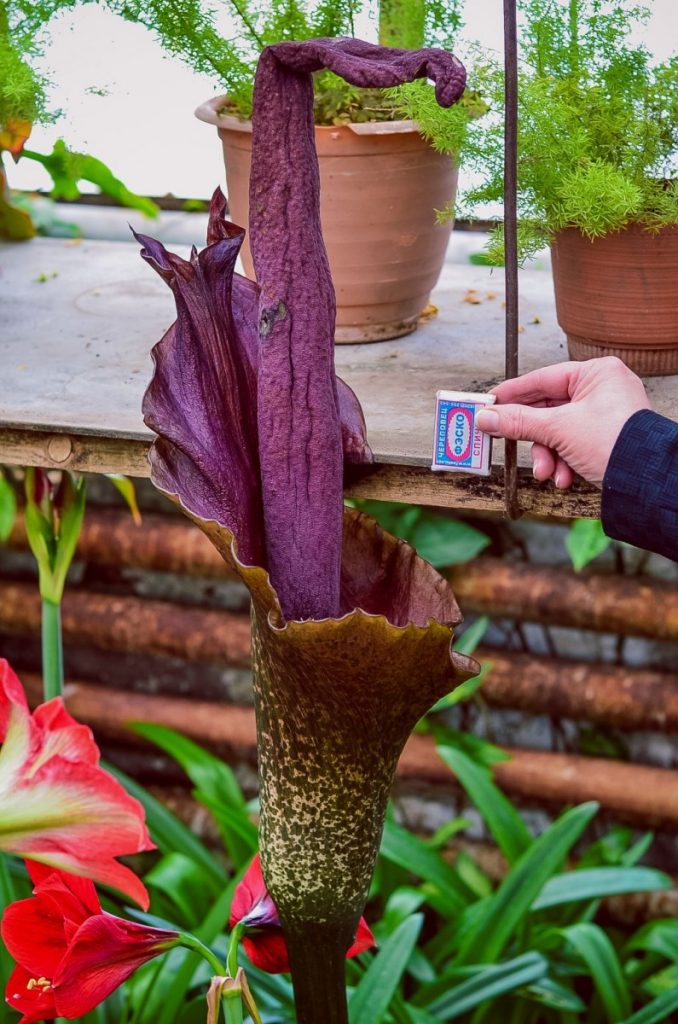

The size of the flower is amazing
Diseases
The plant is resistant to almost all known diseases. The only problem that can arise is bulb rot. Usually it is provoked by excessive watering.
Pests
Pests are also not able to cause significant damage to the palm tree. Only occasionally a spider mite or aphid can appear on young leaves, which will not be difficult to get rid of with the help of insecticides.
Other problems
Another problem that can be faced when growing this amazing palm is drying out the leaves. This usually indicates a lack of watering or light.
Diseases and pests
The amorphophallus flower is resistant to disease infection. However, pests can cause a lot of problems, especially when grown next to other plants. The most dangerous are root nematodes and mealybugs. They are difficult to detect in the early stages, so it is important to observe prophylaxis - treat the soil before planting.
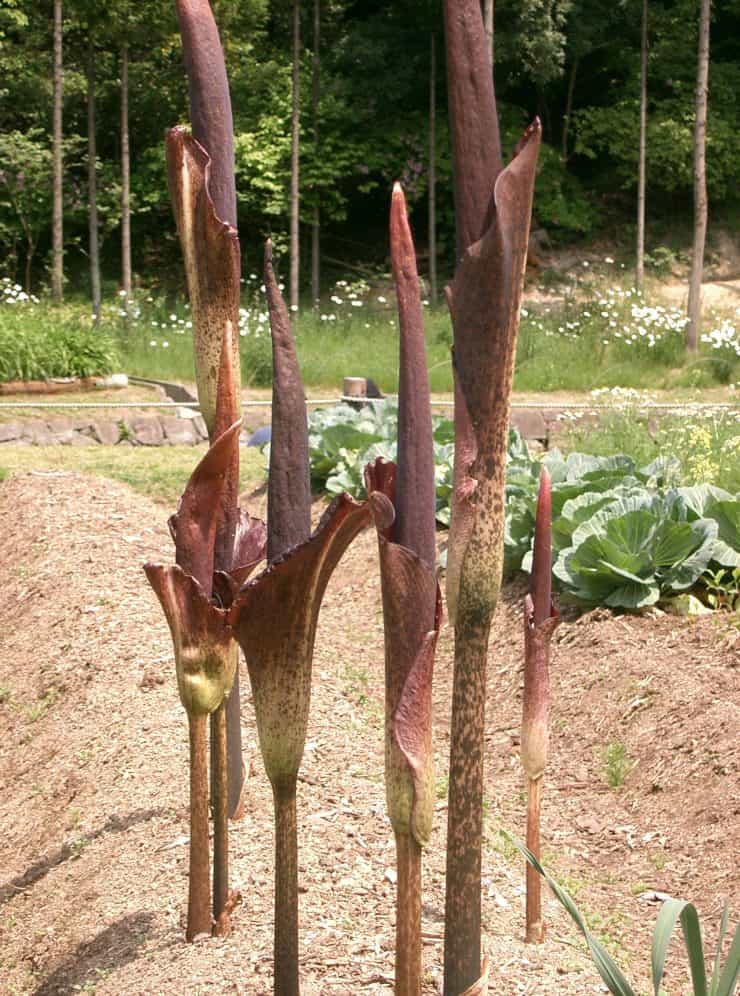

Aphids and spider mites are less dangerous, but they are much more common. They lend themselves well to destruction by folk methods and chemical insecticides. It is important to carry out processing at least twice, and also to change the old soil as much as possible.
Interesting Facts
- Amorphophallus is sometimes called the Voodoo lily.
- Because of the intolerable smell, people actively destroy the plant in wildlife if it grows near their homes.
- When grown at home during the flowering period, the palm is often taken outside. It is not possible to be in the same room with her.
There are many types of plants and trees in the world, which are the most unusual. Amorphophallus Titanic (lat.Amorphophallus Titanum) turned out to be an excellent example. This plant grows in the jungle of Sumatra and has an unpleasant smell, reminiscent of the rotten smell of fish or rotten eggs, which is why it is also called "carrion flower". Amorphophallus Titanic has the largest inflorescence in the world. Have you heard of this before? Then it will be interesting for you!
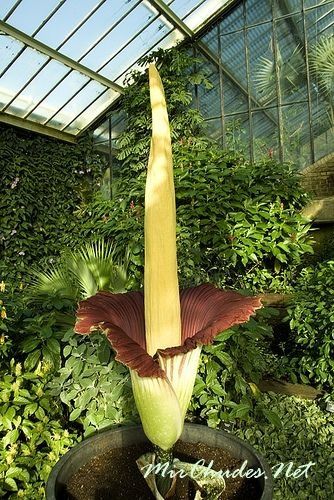

The unusual flower amorphophallus is huge, its growth can reach 2.5 meters in height with a weight of 75 kilograms. Therefore, it can be safely called the largest flower on earth. It has very bright, catchy colors. It resembles a phallus in shape, which is why the flower got its name. At home, such names as "Serpent Palm", "Voodoo Lily" or "Devil's Tongue" were still entrenched for him.


An unusual flower lives up to 40 years, but during all this time, it blooms only 3 or 4 times. Under favorable conditions, it can bloom for the first time at the age of five. Over the course of a year, the amazing plant transforms several times: it immediately resembles a small chestnut tree, then a giant head of lettuce, and then a huge red flower.
Voodoo Lily blooms for about two weeks. In an almost completely blossoming state, the flower lasts for about 72 hours. Then the inflorescence begins to close, wither and slowly sink to the ground. After the flower dies off, one stem remains, the size of a small tree.
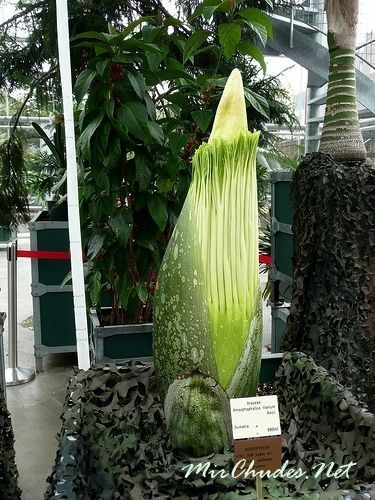

During flowering, due to the overexpenditure of nutrients, the plant is severely depleted. Therefore, it enters a state of dormancy for up to one month in order to gain strength for the further development of the leaves. But if there are not enough nutrients, then it may be in "hibernation" until next spring. During the growth period, Amorphophallus Titanic grows up to 10 cm per day.
Of course, this is not the only feature of the flower. As it grows, Amorphophallus Titanic gives off a fetid smell of rotten meat. Of course, this does not happen just like that. This smell serves to attract pollinating insects, to exchange pollen, and thus makes reproduction possible. Even outwardly, the plant (dark red inflorescence) creates the illusion of "rotten meat".When Titan Arum blooms, the temperature of the ear (the very top of it) becomes identical to the temperature of the human body, while the smell is easier to evaporate.


Amorphophallus Titanic was discovered in the jungles of Sumatra (west of Indonesia) by the Italian botanist Odoardo in 1878. The largest specimen known to date was presented at the Botanical Gardens in Bonn, Germany in 2003, which reached 2.74 meters in height.
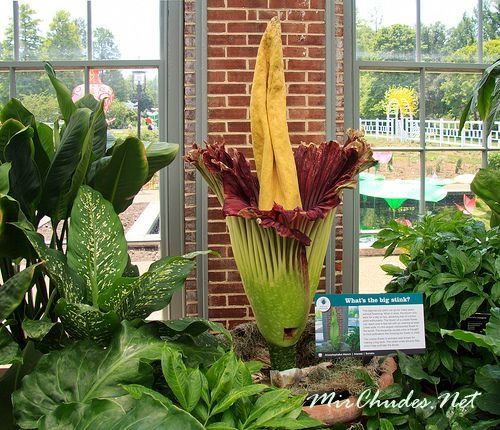

Due to its unbearable nature, the Amorphophallus Titanic plant is extremely difficult to cultivate, so not every botanical garden can boast of such an exotic flower. All over the world there are now about 122 copies. In Germany, the plant is represented in seven cities.
Amorphophallus titanic is an unusual and unique plant. Its place of growth is considered to be tropical forests in South Africa, the Pacific Islands, Vietnam, India, Madagascar. Interestingly, the plant usually grows in polluted areas.
Plant life cycles
By the end of March, amorphophallus comes out of dormancy. The tuber with awakened buds is transplanted into fresh soil. The sprout develops very quickly, it needs abundant watering and regular feeding. A plant over 5 years old is capable of blooming. By the end of spring, the flower blooms, it pleases with its unusual beauty for about two weeks. Some varieties hibernate immediately after flowering, while others grow leaves.
Beautiful greenery on a dense stalk resembles a palm tree. The leaf grows back quickly, but remains only until August or early September. Gradually, the entire ground part dries up. For the rest period, feeding is stopped, and watering is limited to a few spoons per month. The air temperature should be maintained at the level of + 5 ... + 7 0C. You can put the tubers in the refrigerator.
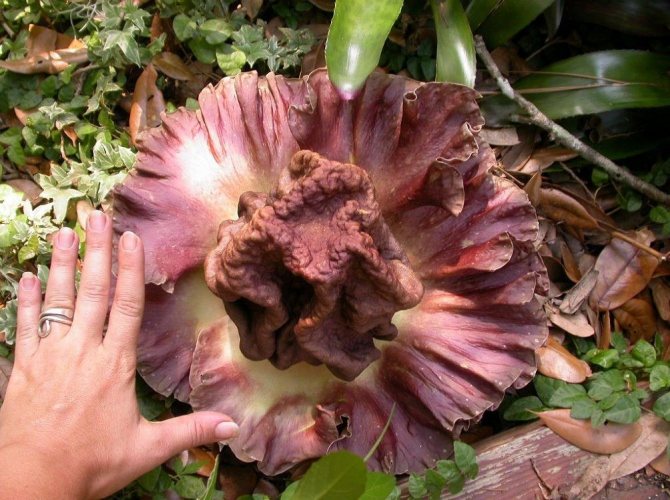

Characteristic
Amorphophallus titanic has a unique cob inflorescence and large tubers. The plant is characterized by the presence of an erect stem, one leaf, the size of which can reach 3 meters. The first time after planting, the flower blooms after 10 years. And the aboveground green part of the plant appears as the flower withers. After that, berries of bright colors are formed at the base of the ear. Flowering occurs irregularly. Sometimes it takes 6 years to form an inflorescence, and sometimes it is possible to observe almost every year how one of the unique plants of the planet develops.
Amorphophallus belongs to the Aroid species. An interesting fact is that another name for this plant is "Voodoo Lily". Some representatives of African tribes call it "Devil's tongue". Some growers call it "The Snake on the Palm", and because of the unpleasant smell, another name is "Cadaveric scent".
Hibernation time
As soon as autumn comes, the leaf of the tropical beauty will begin to wither. Having noticed this, it is necessary to cut it off, carefully remove the tuber from the ground, shake it off the soil and carefully examine its surface. Identified rotting locations on the tuber must be eliminated. It is also worth cutting out dead areas.
The "operated" places should be treated with a weak solution of potassium permanganate. After that, the tuber can be considered fully prepared for winter, put in a cardboard box and put into a closet on the balcony. When preparing for the dormant period of the plant, be guided by the recommendations from the table.
Table - Basic storage conditions for amorphophallus tuber
| Hibernation period | Duration | Storage conditions | Allowable temperature | Deadline for disembarkation |
| September-February | 5-6 months | - Dry; - cool; - dark | 12-15 ° C | End of April |
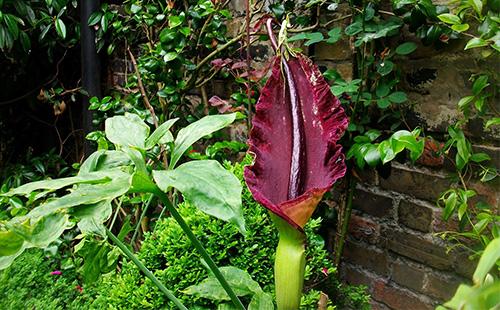

Care principles
Growing this plant on your own is very difficult. In most cases, the flower is acquired in the dormant stage, when its leaves turn yellow and fall off.During this period, indoor plant lovers think that the flower has died and buy a new one. In this regard, it must be remembered that the growing season of rest of the flower is 6 months. As soon as this period passes, the culture gives new leaves and departs from the vegetative period.
The plant is not very demanding for watering. Amorphophallus titanic is watered during active development, once a week. For these purposes, it is good to use a spray bottle. During dormancy, watering is reduced to a minimum. The bud begins to form even before the leaves form. The plant blooms for 2 weeks. At the same time, the tuber decreases in volume due to the fact that it consumes many minerals that are vital for the growth and development of the plant. Female flowers open earlier than male flowers. Because of this, Amorphophallus is not a self-pollinating plant.
In order for the plant to pollinate, several more specimens are needed, while they must bloom at the same time. After pollination, a collection of juicy berries with a large number of seeds is formed. In this case, the ancestor plant dies. After flowering, a large leaf should form.
The flower has a very unpleasant aroma, reminiscent of the smell of rotting meat. In natural conditions, it attracts the attention of flies that pollinate the plant. With self-cultivation, seeds are not formed
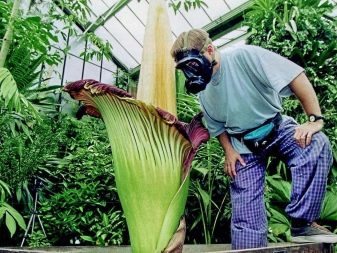

Botanical characteristic
Amorphophallus is a deciduous plant of the Aroid family. In the wild, it can be found in Indochina. From the ancient Greek language, the name of the culture is translated "formless process". The vegetable juice is poisonous and can cause severe dermatitis and skin irritation. The snake palm is an ephemeroid plant with a short life cycle. Amorphophallus is dormant most of the time, the growing season lasts no more than 5 months.
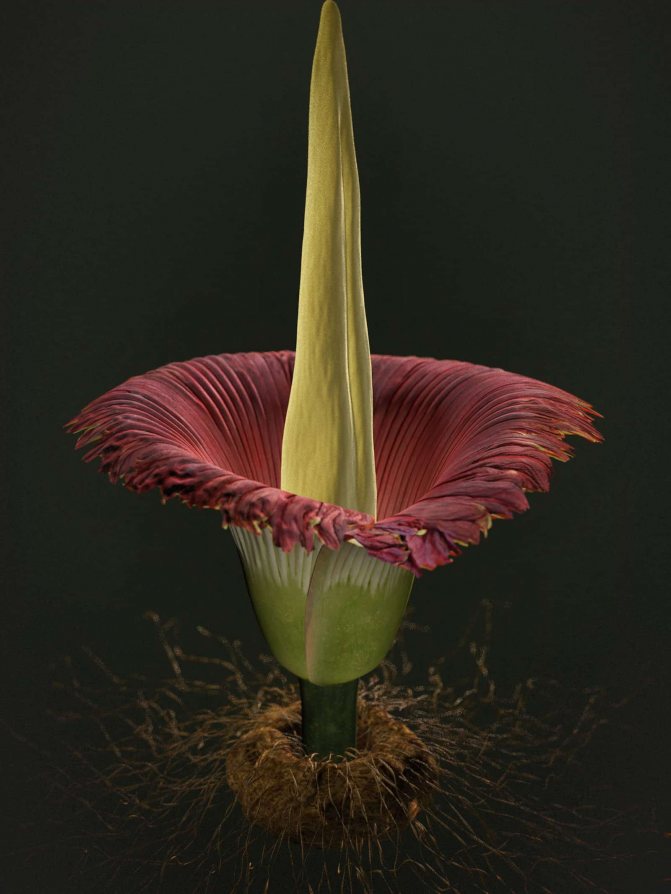

The root system is represented by a powerful tuber that can grow up to 5 kg. The stalk is thick and lignified, at first one dissected leaf up to 50 cm long appears on it. It dies off after 2-3 months, but every year it becomes more and more. Flowering lasts no more than a month. The flower is represented by a large ear with a blanket, exudes the smell of rotten fish or meat. When pollinated, an infertility is formed from a variety of berries with seeds. After that, the flower again goes into a dormant period.
Crown formation
The flower has a tuber from which a giant leaf grows. Usually one is formed, in rare cases 2-3 pcs. It can be several tens of centimeters wide. On the tuber, it is one period of development, after which it disappears. After 6 months, a new one grows, more feathery, wider and larger. As the flower growers say, the leaf resembles the crown of a palm tree.
Leaves
Amorphophallus leaves are tripartite. The leaf plate only lives for a few months.
At the end of the life cycle, it acquires a yellow color. From year to year, the crown grows higher and higher and a dissection appears.
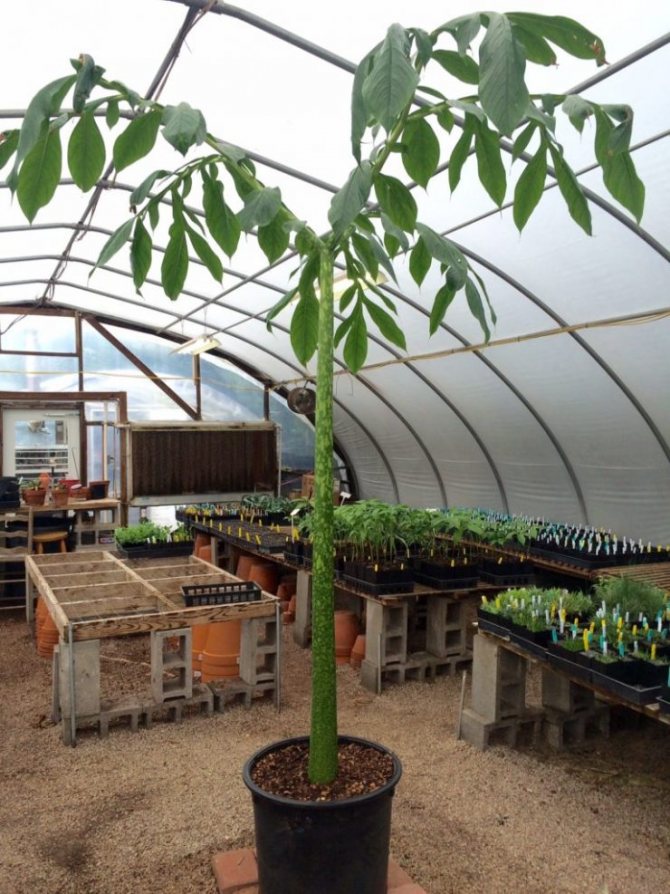

Landing
For planting, the substrate is prepared in advance. In its natural environment, the flower loves soil enriched with limestone. At home, a mixture of soils is considered favorable for growth and development, in the structure of which there are inclusions of peat, sand, humus, sod soil. In addition, all these soils are mixed with dressings, this enriches the plant with the necessary minerals and a complex of vitamins. In such an environment, the plant grows well.
In the upper section of the tuber, stem roots may begin to form. Because of this, the substrate is often poured into the plant pot. It is not necessary to allow the nodules on the mother tuber to be exposed. Tubers begin their activity in the spring, this becomes noticeable when sprouts appear on its surface. The size of the container should be three times the diameter of the tubers.
At the bottom of the container, drainage must be done. Half are covered with soil, a hole is made where the root system is located.Then the roots are covered with the remaining substrate, leaving the upper part of the sprout open. At the end of the procedure, the plant is watered and placed in a well-lit room.
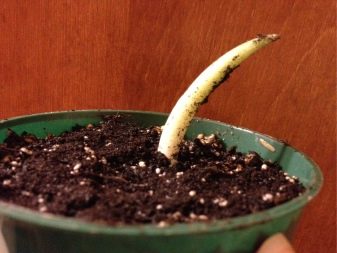

Rest periods
A dormant period is required for all Amorphophallus palms, at this time (most often it coincides with the winter months) the leaves wither and it may seem that the plant has died. As soon as this period begins, watering is stopped, and the wilted leaves are carefully cut off near the ground. The ideal temperature for rest is around 12 ° C. Therefore, the pots with plants are rearranged in a dark, cool place, not forgetting to occasionally moisten the soil surface. In mid-spring, overwintered Amorphophallus are transplanted into larger pots. You can also take them out of the pot after the leaf has wilted, cleaned from the ground and stored in a cold place until spring in a container with peat. In flower shops, tubers are bought in winter, and then kept in a refrigerator along with vegetables until spring. It is worth inspecting the planting material often in order to prevent decay, and also to notice the moment of the beginning of growth in time. When it comes (but no later than the beginning of April), the tubers are planted in pots, trying to leave some free space on top to add soil as they grow.
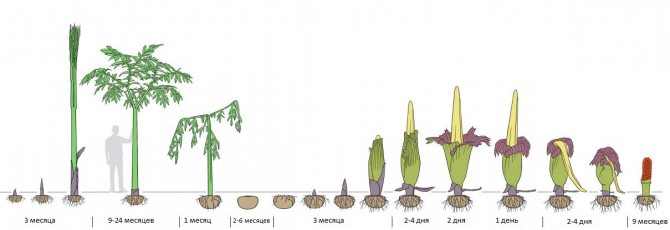

Reproduction
This process takes place by dividing the tubers. The largest ones are used. They are dug out of the container, some are cut off and distributed in containers, the remaining tuber is buried back. After a five-year period after planting, the plant can be considered fully formed. The next type of reproduction is the use of seeds. They are sown in a prepared container with a substrate and watered.
The best time for this is spring. The optimum temperature for this process is +18 degrees.
Reproduction of amorphophallus
Amorphophallus is propagated mainly by "children". From time to time, children appear from below, next to the leaf of an adult plant. Under favorable growth conditions, these babies sometimes almost reach the size of their parent during the season. But experience shows that amorphophallus is not very generous with children.
In addition to the reproduction of amorphophallus by children, there is another rare and interesting way of vegetative propagation of this plant, which many owners of the "snake palm" are unaware of.
During the growing season of amorphophallus, in the very center of its leaf (in the very place where the leaf divides into three parts) a nodule rudiment is formed. It is small - therefore, perhaps not all growers pay attention to this neoplasm.
At the end of the season, when the amorphophallus leaf is almost dry, carefully separate this developed nodule. Dry a little at the nodule where it was attached to the leaf. Place the tuber in a small container. And then you will have another amorphophallus!
It happens that the planted leaf nodule begins to germinate immediately. And it also happens that a sprout in a leaf nodule of amorphophallus appears only next spring.
Of course, from a small planted "baby" or nodule, the peduncle does not develop immediately. This is preceded by 5 years, during which only a leaf is formed. And every year the size, leaf dissection and tuber weight increase. Finally, when enough stored substances have been accumulated and the diameter of the tuber reaches 5-30 cm (depending on the species), an inflorescence is formed.
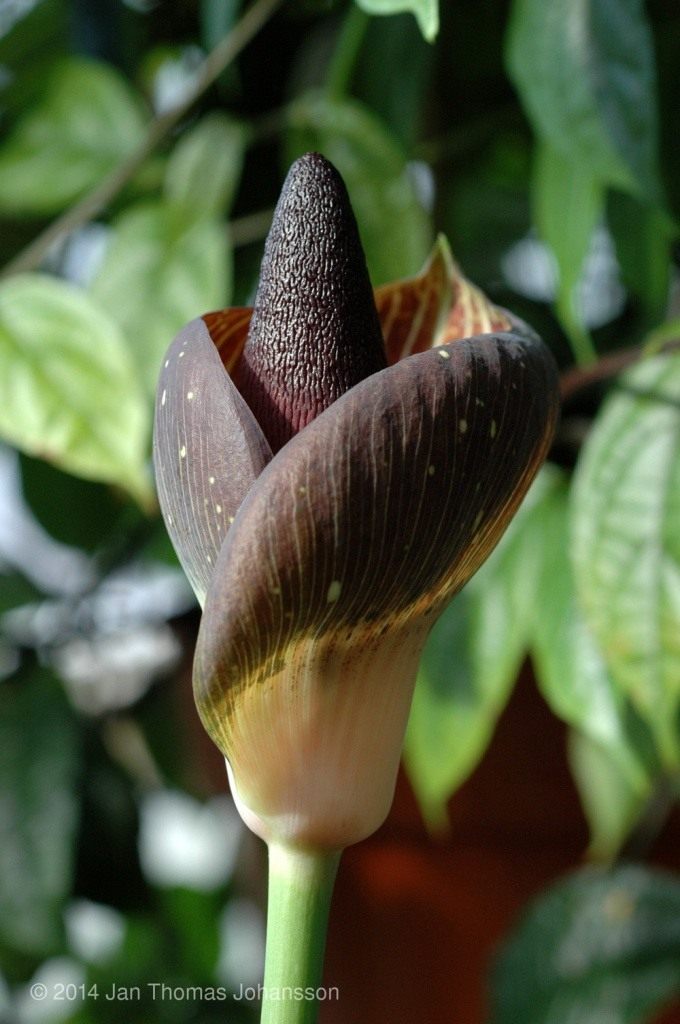

Amorphophallus leafless (Amorphophallus aphyllus)
Benefit brought
The plant's tubers are used in the culinary field. This plant is especially popular in Japan. Tubers are added to the first and second courses. In addition, flour is made from them, it is used for the production of homemade pasta. Dishes help eliminate allergies, remove toxins and toxins. In addition, they are used for weight loss.


Using
Amorphophallus serves as a wonderful decoration for the garden and premises. Even without a flower, its unusual leaf attracts a lot of attention.With the appearance of inflorescences, amorphophallus is best taken out into fresh air, where its intoxicating aroma will not bother much.
Tubers of amorphophallus cognac are used for food. They taste like sweet potatoes. In Japan, the product is added to soups and meat dishes. Dried tuber flour is used to make noodles and some types of tofu cheese. It also serves as the basis for many products for patients with diabetes mellitus. It is also believed that eating amorphophallus tubers cleanses the intestines and reduces weight.
Other types of Amorphophallus
- Amorphophallus "Cognac". It grows in Southeast Asia, China and the Korean Peninsula. It is slightly smaller than Titanic, but of great interest to botanists. The plant is widely used for growing in greenhouses and at home, despite the repulsive smell.
- Amorphophallus pion-leaved. Grows in China, Vietnam. One of the names is "Elephant Yam". The tuber of the plant weighs up to 15 kg, and reaches 40 cm in width. This type is grown for human consumption. The tubers are fried and boiled like potatoes and ground into flour.
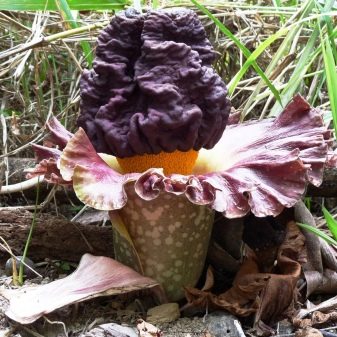

- Amorphophallus bulbous. It is rather an exception to the rule. It is considered the most beautiful of all types of this plant. It has a pointed ear, where there is a clear border of male and female flowers and a pink haze from the inside. In appearance it resembles a calla flower. And probably one of all types does not have a repulsive smell.
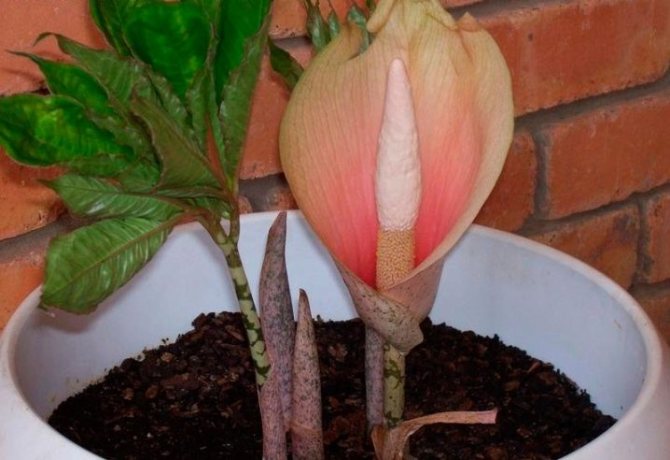

See the stages of flowering Amorphophallus titanic in the next video.
Advantages and disadvantages
- Among the advantages of the plant, it is worth noting:
- its extreme exoticism;
- absolute unpretentiousness in care;
- attractive appearance;
- the opportunity to replenish your garden with a new pet that requires regular care;
- the opportunity to diversify your diet, since in the East, flower tubers are used for food.
- Disadvantages of amorphophallus:
- the rarity of flowering and fruiting;
- the obligatory presence of a large free space and a large container for growing a flower;
- the need for an annual transplant.
Growing difficulties
The main problems of this flower are associated with improper watering. With other errors, the decorative appearance of the sheet deteriorates.
Diseases, pests
Damage by aphids or spider mites is possible. To prevent aphid infestation, protect the container with a flower from infected plants. Spider mites are caused by dry air.
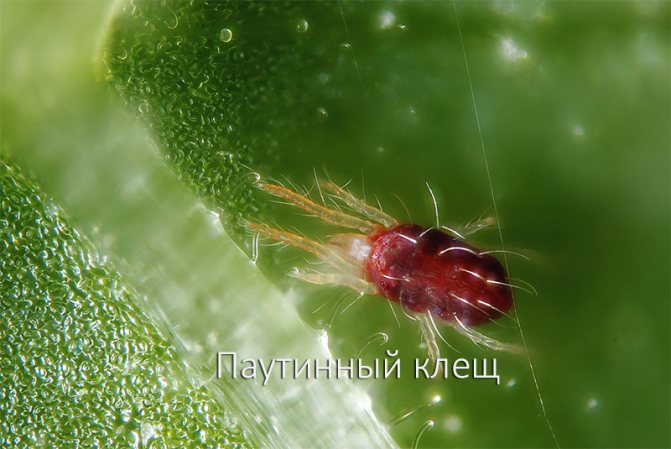

Small white dots appear on the surface of the leaf, and small ticks and cobwebs appear on the lower part of it. To prevent this problem, frequent spraying and increased humidity are required.
Pests can be dealt with with Fitoverm by applying two spraying procedures with an interval of 10 days. This drug will help to additionally get rid of midges that appear on the soil with excess watering. In this case, the soil in the pot is sprayed with the preparation.
Care errors
| Problem | Cause |
| Dark spots on the tuber and at the base of the petiole, which quickly spread. | Excessive watering or low temperature. |
| The leaf dries up. | Lack of feeding or too dry air. |
| The leaf darkens. | Not enough light. |
| The leaf is covered with light spots. | Sunburn. |
Transplant procedure and preparation for it
Since amorphophallus has a pronounced rest period, transplantation for it is an annual procedure. It is carried out in early spring, as soon as the growth point begins to swell. It is necessary that the container is 2-3 times wider than the tuber. Suitable pots have approximately the same diameter and height. The preferred material is ceramics, such containers are more massive, which means they are stable.
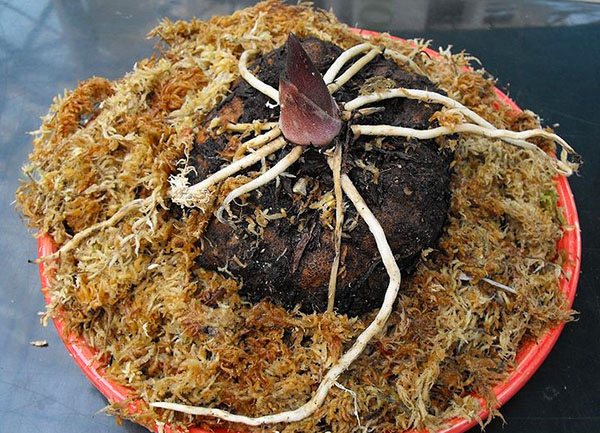

Amorphophallus is transplanted every year as soon as the tuber begins to show signs of awakening.
The main requirement for the soil is looseness and nutritional value. There is a special soil for the Aroids on sale, but you can mix the substrate yourself:
- fertile turf, leafy soil, peat chips, humus, coarse river sand (equally);
- universal soil for indoor plants, rotted compost or powdered dry manure, peat, sand (1: 1: 1: 0.5);
- garden soil and sand (4: 1). A useful additive is superphosphate (20 g per 3 liters of the finished mixture).
Transplant procedure
- Cover the hole for the water drain with a ceramic shard, fill a third of the pot with coarse sand, brick chips, small expanded clay.
- Add freshly prepared disinfected substrate (up to half the height of the container).
- Examine the tubers. Cut rotten or dry areas to healthy tissue with a sharpened, clean knife. Treat "wounds" with iodine, green herbs or sprinkle with crushed chalk, activated carbon, cinnamon. Let dry for 2-3 hours. Experienced growers, in order to minimize the risk of infection, after each cut made, it is recommended to lower the knife in boiling water.
- Make a hole in the soil, fill it with sand. Dip the bottom third of the tuber into it.
- Add soil around the edges, occasionally shaking the pot gently. Make sure that the growing point remains above the soil surface.
- Water the plant moderately, place it where it will be provided with diffused bright light.
- Sprinkle the soil several times during the season - "offspring" and new roots are formed closer to the top of the parent tuber.
The transplanted amorphophallus first forms a flower, then a leaf
Amorphophallus: characteristic
Amorphophallus translated from Greek means "shapeless" and belongs to the Aroid family, which includes more than 170 plant species. Titan arum (Amorphophallus titanic, the world's largest inflorescence, belongs to this genus. It can reach a height of 2.5 m and a width of 1.5 m. In second place is Amorphophallus gigas, which is higher, but has a slightly smaller flower.
Amorphophallus is a typical plain plant that grows in tropical and subtropical zones, from West Africa to the Pacific islands. Most amorphophallus species are endemic. They grow mainly on disturbed grounds, such as secondary forests, and are also found on rocks (on limestone soil) and in weedy places.
These plants come in all sizes, from small to gigantic. They grow from underground tubers the size of a grapefruit and weighing about 5 kg, some from rhizomes or stolons. These plants have a dormant period, some of them are evergreens.
The tuber is compressed-spherical, sometimes unevenly cylindrically elongated, rep-shaped or conical in shape. It is from this that the plant develops. In some species, the tuber reaches a weight of 90 kg. The tuber is dormant for about six months. A thick shoot emerges from the tuber, powerful and strong. the same imposing leaf, dissected along the edges, departs from it. When grown in amorphophallus at home, the leaf unfolds in April. It is unfolded until October. After which it turns yellow and dies off. This indicates a dormant period of the plant. In the spring, a new leaf appears, larger, more powerful and stronger than the previous one.
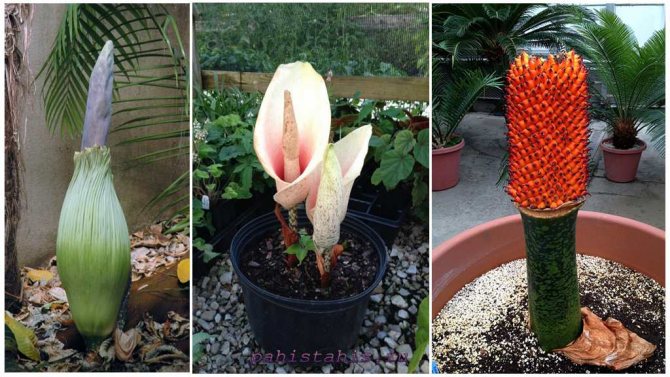

Three periods of flowering amorphophallus: bud, flower, fruit
The flowering of amorphophallus is short-lived. It lasts about 14 days. During this period, the tuber shrinks and shrinks in size. All of its nutrients are used to maintain the flower. After flowering, the plant is restored within a month. Then he releases a new sheet.
If the plant is accidentally pollinated, then fruits are formed in the lower part of the ear, in which the seeds are located. After the fruit is fully ripe, the flower dies. As a rule, pollination occurs only in natural conditions; in domesticated flowers, the flower is rarely pollinated. For pollination to occur, at least two plants must bloom nearby.
Types for indoor cultivation
Amorphophallus cognac (synonym A. Rivier)
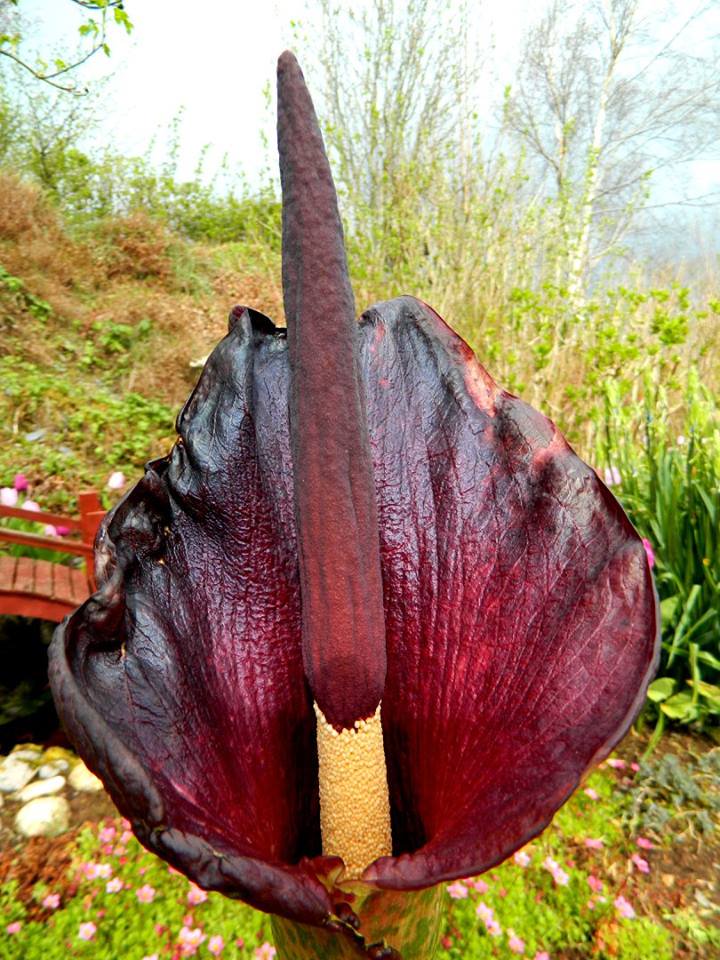

It has several "poetic" names: the tongue of the devil, the palm of the snake, the voodoo lily. Homeland of the species monsoon forests of southern China and South Vietnam. Cultivated as a food plant from Japan and China to Indonesia.
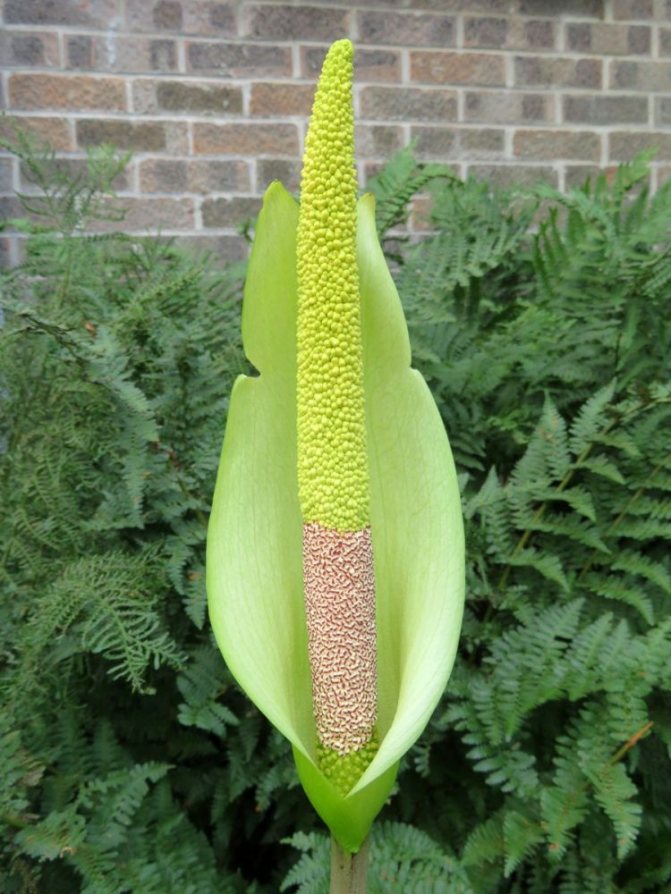

The tubers have the shape of a flattened ball, can reach a diameter of 25-30 cm. The inflorescence is black-violet, the ear is up to a meter long, the cover is shorter, cherry or burgundy, lighter outside. Flowering lasts about two weeks and it is truly a fantastic sight.
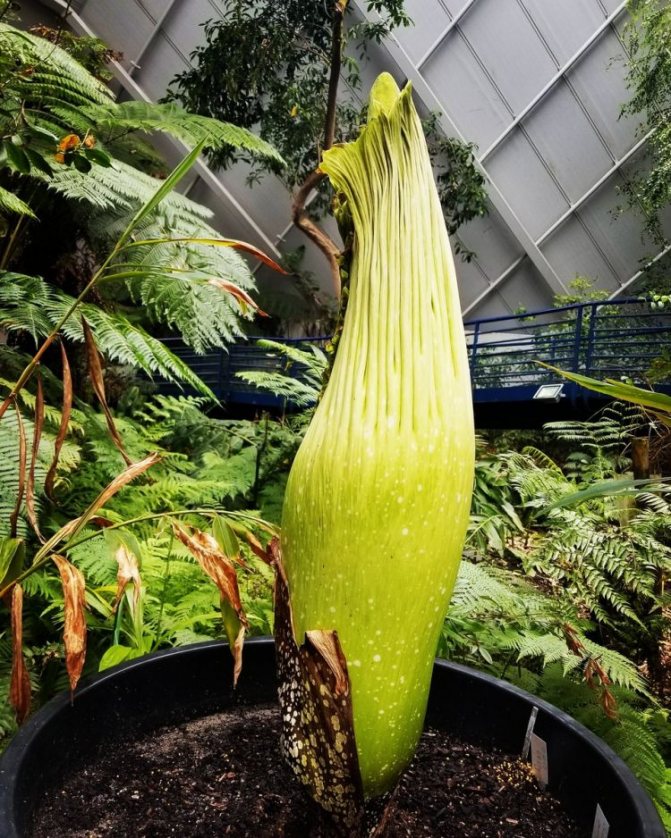

But there is a problem - the flower exudes a scent that is attractive to flies, but not to the human sense of smell. The smell of blooming amorophallus is not compared with anything!
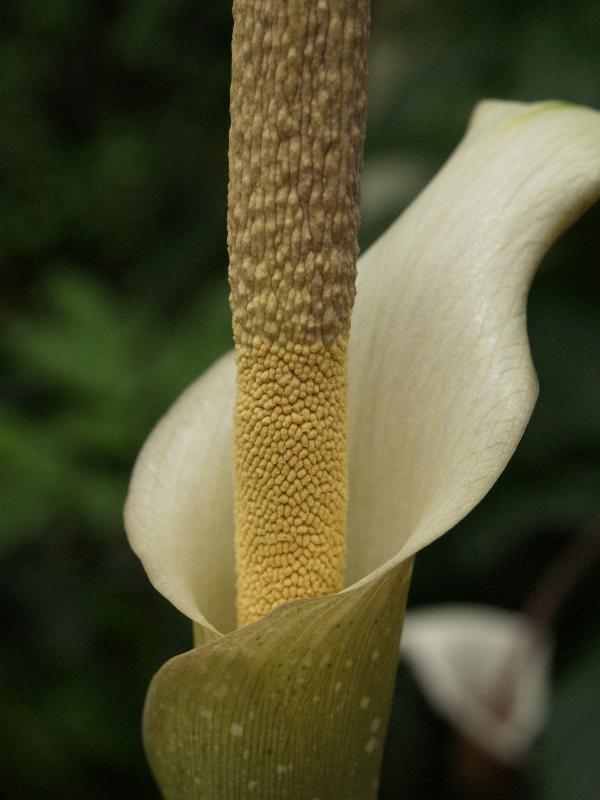

As a consolation, we can only say one thing: this is exactly the case when beauty requires sacrifice!
If you want to admire the amorphophallus flower, you will have to endure. However, the strong smell lasts no longer than three days: it appears when blooming, gradually intensifies, reaches a peak on the second day and is practically not felt by the end of the third day.
One leaf, on a long petiole, reaches a height of 1 meter. The leaf plate in an adult plant can be up to 2 m in diameter and looks like a crown of a tree or a huge open umbrella.
Medicinal properties.
Amorphous seeds contain amorphous glycoside, which has a calming effect on the central nervous system. Also has a cardiotonic effect. On the basis of this plant, the drug "fruticin" is prepared, which is used for vegetative and cardiovascular neuroses, paroxysmal tachycardia.
Studies have shown that in places with an increased radiation background, gas pollution, where there is an increased content of toxic substances in the air and water, amorphophallus feels great, and even grows faster. And what is interesting - within a radius of several meters around the plant (depending on age), all these indicators improve.
In pharmacies, futicin is sold in tablets of 0.05 g. Take 1 tablet 2-3 times a day after meals. A course of treatment is carried out for 20-30 days, taking breaks for 3 days after every 10 days of admission. If there are no side effects, the dose can be increased to 0.1 g or 2 tablets at a time.
In traditional Eastern medicine, the whole plant is used for medicinal purposes. Inflorescences are used for pain in the bones, inflammation of the eyes, as an antipyretic agent. In China, tubers are used for cancer. But making them requires knowledge and experience. And since plant preparations have toxic properties, it is not recommended to make them yourself.
Watering
A tuber that has left the dormant period does not need watering. Even when it blooms. Moreover: from the water that gets on it, it can easily rot.
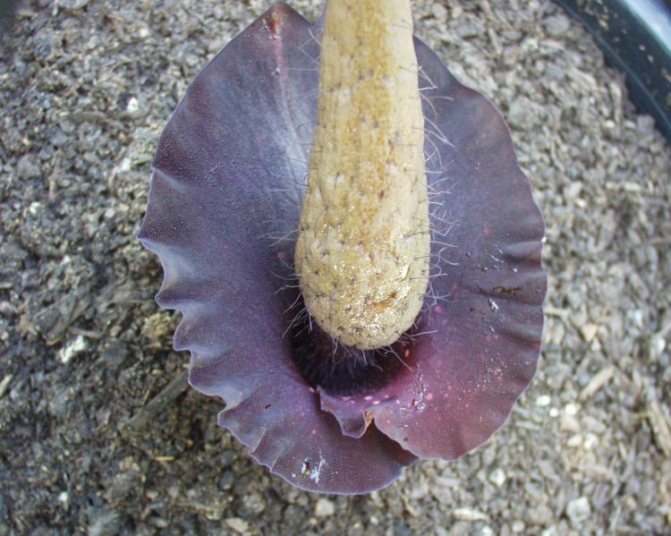

After all, the roots of amorphophallus grow back after flowering! But when a leaf appears, the plant needs to be watered abundantly.
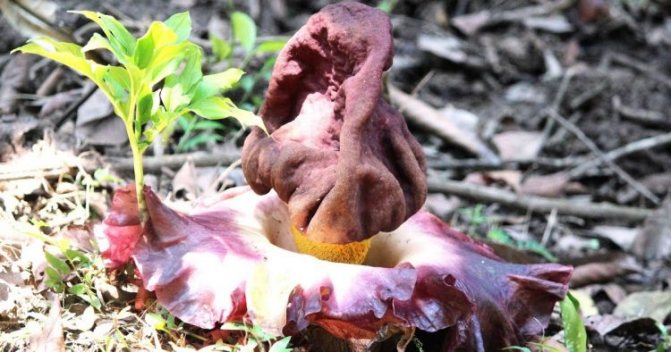

But, of course, do not pour and try to prevent water from getting on the tuber. When the leaf begins to turn yellow, the amount of watering is reduced - the amorphophallus ends the growing season.
Photo of amorphophallus
Read: Adiantum - tips for growing, types and varieties, features of care and application in design (80 photos)
Did you like the article? Please share with your friends 

1+
Write a comment
New design
Provence curtains - design ideas and an overview of the ideal combinations of curtains in a rustic style (110 photos and videos)
Minimalism in the apartment - interior ideas and design options. Tips for applying different styles (100 photos)
Kitchen-living room 20 sq. m. - design ideas, interior design options and an overview of the most stylish combinations (110 photos)
Living room decoration - tips for choosing colors and materials. An overview of the most beautiful living room design ideas (90 photos + video)
Amorphophallus bulbiferous
The homeland of this species is North India, Himalayas, Burma.
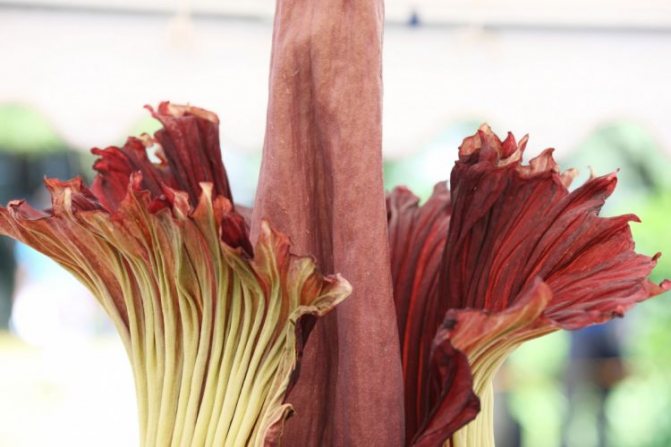

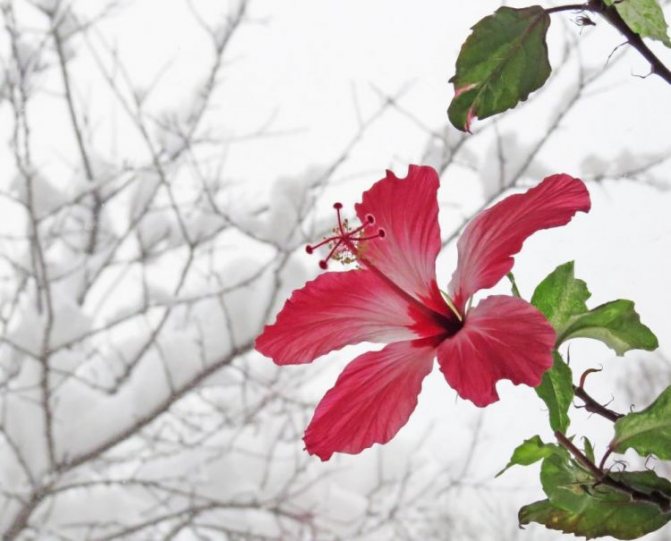

Hibiscus - seedling selection, care, reproduction and advice on watering the plant. 110 photos and video review of the flower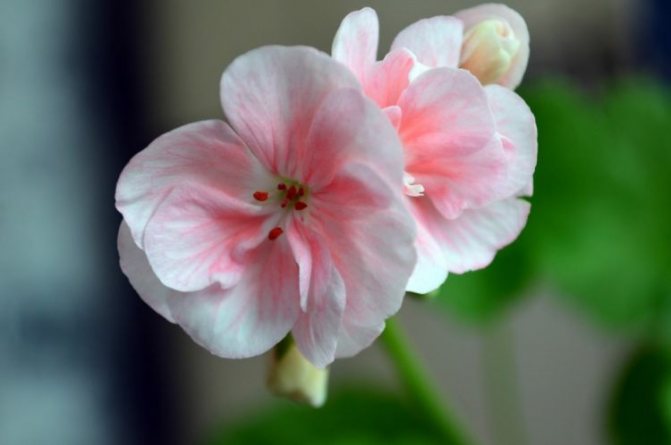

Geranium - secrets of growing, options for use and features of use in decor (95 photos and videos)
- Ahimenes: types, planting, care, reproduction and secrets of use in the garden and in the interior (115 photos)
The tuber is smaller than that of a. cognac is only 7-8 cm in diameter.
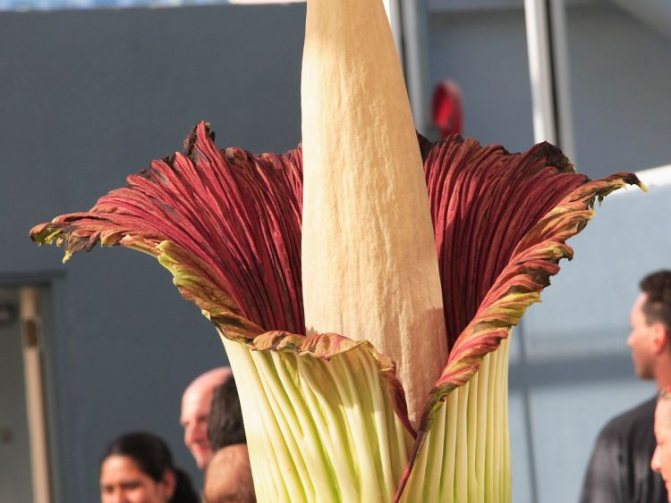

It blooms only in adulthood, and subsequently the plant may not bloom annually. The smell is not as deadly as that of its famous relatives, but quite strong and unpleasant. It lasts only a few hours after the blooming of the flower, then disappears.
The ear is cream-colored, no longer than 30 cm, the veil is light pink and does not exceed the length of the ear: the whole flower can be compared to an inverted horn. One leaf, petiole length approx. 1 meter.
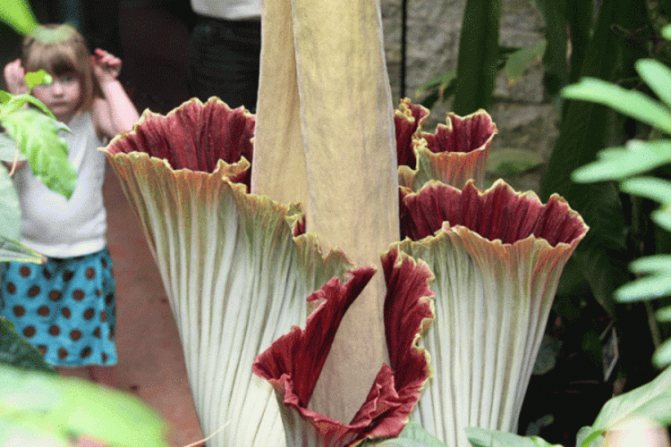

Seasonal development scheme
In early spring, a sharp sprout emerges from a tuber planted in the ground. If the plant is young enough, then that single leaf will quickly develop from it. If the tuber is large enough, and the plant is more than five years old, then the flowering period will first begin. That is, a peduncle gradually appears from the ground, which grows until the leaf appears.
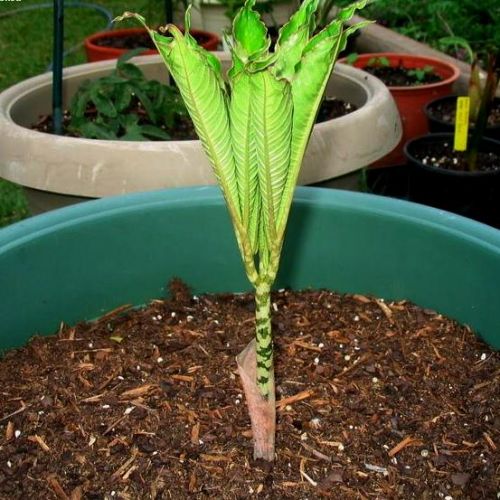

Amorphophallus leaf development
After the inflorescence withers, a leaf begins to develop, which can be up to one meter across in an adult specimen.
In August - September, the leaf slowly begins to wilt and completely falls off by winter. And in the spring everything starts all over again. Moreover, every year the leaf increases in size, and its surface becomes more and more dissected.
Amorphophallus transplant
As the bulb grows and grows in diameter, in the spring, into larger pots. Transplanting large plants can be difficult - in such specimens, they simply change the topsoil to fresh every year.
The procedure for transplanting amorphophallus: Fill about a third of the pot with drainage. Pour soil on top (up to half the pot). Add sand. Dip the tuber in the sand and sprinkle with soil. Water the plant moderately until it starts to bloom.
Amorphophallus: feeding
After germination of fresh seedlings, amorphophallus is fed every two weeks with organic and mineral fertilizers, alternating between them. It should be borne in mind that amorphophallus needs a fairly large dose of phosphorus. To quickly increase the mass of the tuber, it is necessary to regularly fertilize the plants, maintaining the ratio of nitrogen, phosphorus and potassium in a ratio of 1: 3: 2 or even 1: 4: 1. Agricola and Ideal are good for feeding. These fertilizers can be combined with double superphosphate. For 1 tsp. of the Agricola drug, you should take a teaspoon of double superphosphate. This amount of the drug is calculated for 3 liters of water.


Fertilizers for amorphophallus
For large tubers, one part of humus can be added to the standard aroid substrate. It is recommended to water abundantly the soil in a pot before feeding.
Attention!!!
The plant is fed immediately after watering. It is not recommended to apply fertilizers if the plant is damaged, sick, or was recently transplanted.
Features of room content
Amorphophallus is easy to grow indoors. It does not have any special requirements for the content - warmth during the growing season, bright diffused light and slightly increased air humidity.
Video: description of amorphophallus
Types of amorphophallus
Despite the large number of amorphophallus species, only a few of them are used in indoor floriculture.
Cognac
Amorphophallus cognac is a perennial plant grown from a tuber, also often found under the name Amorphophallus rivieri (river). In China, Japan and some other countries it is grown as an edible plant. Various dishes are prepared from dried and chopped tubers - soups, side dishes and seasonings.Due to its ability to lower blood sugar and cholesterol, it is used in dietary nutrition for various gastrointestinal diseases and obesity.
The inflorescence of amorphophallus cognac consists of a long cob of burgundy-purple color, framed by a petal-veil. Female and male flowers form in the lower part of the peduncle, while the crown remains sterile. When grown in a pot, the inflorescence often reaches a height of 80 cm. The green leaf that appears after flowering is strongly dissected, with many small pointed leaf segments attached to a hollow petiole, resembles an umbrella in shape. Every autumn, the leaf dies off, and after a period of dormancy, a new one grows - a little higher than the previous one and more dissected. In indoor conditions, the height of the leaf and the diameter of the crown usually do not exceed one meter.
The amorphophallus tuber cognac is flattened, rather large, 20–30 cm in diameter, growing many roots in the upper part. The plant reproduces easily with the help of the children that form on the tuber.
The flowering of amorphophallus cognac lasts two weeks, usually in March-April, closer to summer a leaf appears. The plant goes through all stages of development in six months and in September, after the death of the leaf, goes into a state of dormancy.
Onion-bearing
Amorphophallus bulbiferous does not bear fruit when kept indoors. The inflorescence consists of a cob about 30 cm long and a pink petal, sometimes with green blotches. The ear does not rise above the veil. The leaf is bright green, strongly dissected, with a hollow petiole. The color of the petiole is very interesting, reminiscent of camouflage - light, with gray-green spots. Amorphophallus bulbiferous reproduces with the help of bulbs that form by autumn at the base of the leaf. Otherwise, the timing of flowering, development and dormancy in pot cultivation are the same as in amorphophallus cognac.
Titanium
Amorphophallus titanic due to its gigantic size is grown mainly in greenhouses. In nature, it practically disappeared, and only in 1993 one of the expeditions to Sumatra managed to find this plant and collect seeds from it. Today, all titanic amorphophallus found in greenhouses are grown from those seeds or have already been propagated.
Blooming amorphophallus titanic is an unforgettable sight. The flower can reach 3.5 meters in height and weigh over 70 kg. The ear rises above the veil and consists of many flowers collected at the bottom. The ruffled bedspread is greenish on the outside and bright burgundy on the inside, reminiscent of an inverted luxurious skirt. The crown of the cob during flowering heats up to 40 degrees, which contributes to the better spread of the eerie odor, thereby attracting pollinators. The inflorescence ripens within a month, then opens sharply and remains in this state for only one night. Therefore, the bloom of the titanic amorphophallus becomes an event for amateurs - each flower is measured, weighed, assigned names, and the measurement results are entered into historical records.
After 4–5 days after the beginning of flowering, the top of the ear is destroyed, and on the lower part, if pollination has taken place, berries are tied. When ripe, they turn bright orange and reach the size of a cherry.
A huge tuber of amorphophallus titanic reaches 90 kg. A leaf up to 6 meters high with a "crown" diameter of up to 4.5 meters develops from a year to one and a half years, then dies off, and the plant begins a dormant period.
Peony-leaved
Amorphophallus pion-leaved outwardly is very similar to titanic, differs only in more modest size. Strongly dissected single leaf about one meter long, pimply petioles with spots grow up to two meters. The inflorescence consists of a creamy cob about 70 cm high and a corrugated blanket, green on the outside and red-brown on the inside.The development of the peduncle, leaf and tubers is no different from the vegetation of the amorphophallus cognac.
Photo gallery: types of amorphophallus
In amorphophallus, cognac and an ear, and a cover of a rich burgundy-purple color In amorphophallus, an onion-bearing ear is almost completely covered with a cover. Amorphophallus onion-bearing reproduces with the help of bulbs that form by autumn at the base of the leaf
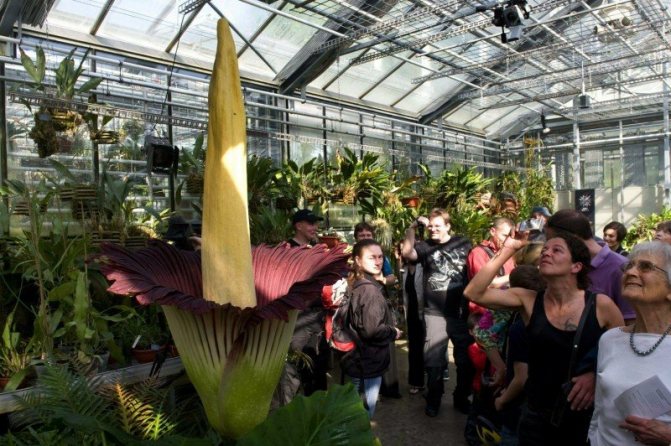

Amorphophallus titanic - the largest flower on planet Earth
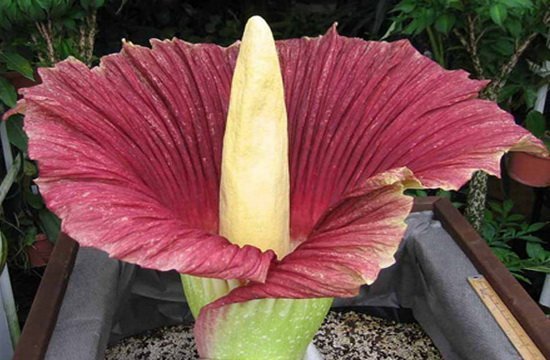

Inflorescence of amorphophallus pion-leaved - a reduced copy of the titanic
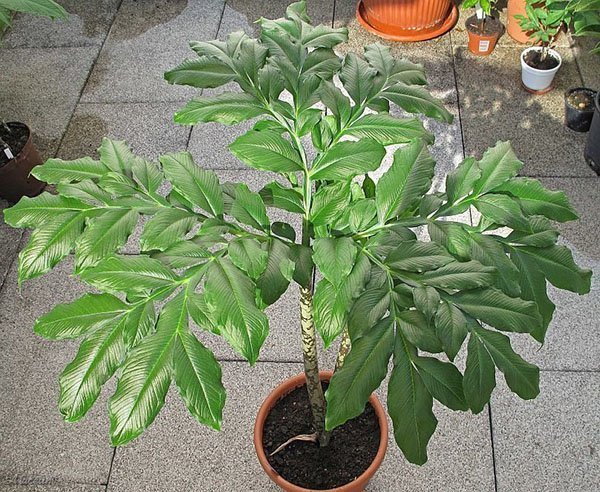

The leaf of the amorphophallus pion-leaved is more like a tree with a spreading crown
Reproduction methods
Amorphophallus is most often propagated by nodules or bulbs (in amorophallus bulbous), growing on the mother tuber. They can be separated when the plant is dormant. Rinse the separated nodules, dip in a pink solution of potassium permanganate for a few minutes, dry and store. Store them, as already described, in slightly damp sand or wrapped in paper, at a temperature of + 10-13 ° C until spring. In March, when sprouts appear, plant in pots. If the main tuber remains in the ground for the winter, then the nodules can be separated in the spring. Similar actions are carried out with onions.
Reproduction is sometimes used by dividing the tuber. In the spring, during awakening, the tuber is cut into pieces according to the number of shoots. Sections are powdered with crushed charcoal, dried in air for several hours and planted in the usual way. It is necessary to cut the tuber with a sharp, clean knife, being careful not to touch the sprout.
Reproduction of amorphophallus by seeds in room maintenance is not used, since it is almost impossible to achieve pollination of flowers.
Amorphophallus is the same flower for an amateur. If you like unusual plants, and this friend is unusual in everything, if it gives you pleasure to watch the development of a curiosity and is not afraid of the prospect of sipping the eerie scents of a blooming beauty, then amorphophallus is undoubtedly your flower! Feel free to plant and, given its undemanding conditions, you will certainly wait for flowering.
Amorphophallus: soil
The flower is very picky about the soil. He needs a rich nutrient soil with a slightly acidic reaction, with a large proportion of sand and good drainage. It should consist of 2 parts of humus, 1 part of sod land, 1 part of sand. After a dormant period, the tubers are planted in the ground only after the apical bud starts to grow. Some plant species require the inclusion of clay in the composition. This is due to the nature of the habitat of these species. These include varieties:
- A. muelleri;
- A. paeoniifolius;
- A. prainii.
Amorphophallus is quite unpretentious, but with excessively dense soil, its roots begin to rot. Therefore, the mixture for this flower should be loose and breathable well.
On a note !!!
To enrich the soil with nutrients, dolomite flour is added to it. To create looseness, the soil is mixed with vermiculite and moss (sphagnum).
Description
Under natural conditions, it grows in the southern regions of Central Asia and the European part of the CIS. Amorphophallus giant in natural conditions reaches up to 5 m in height and gives tubers up to 40 kg. The flowers of this plant emit a far from delightful aroma, reminiscent of the smell of decaying meat. This smell is necessary for the plant to attract dung flies, which pollinate this flower. In indoor culture, this type of plant is not found.
Indoor conditions grow amorphophallus bulbous and amorphophallus cognac.
Amorphophallus bulbous is a short plant - up to 1 m in height. It has a thickening in the form of a bulb, which grows under a single cut leaf.
Amorphophallus cognac is found most often in indoor floriculture. The plant also has one leaf, but no thickening. The petiole is brown-green with white spots.When flowering, it gives a large beautiful flower that looks like a calla flower of bright red color. Before the rain, water droplets appear on the tips of the leaves.
Loading ...
This plant is rich in starch; in Japan, a national dish is prepared from the tubers of this plant.
It is used as an ornamental plant that can be used to decorate terraces, balconies, residential and office premises.
Home care
The right microclimate
In order for amorphophallus to feel good and develop correctly, it is necessary to create an environment for it that is as close to natural as possible. Of course, the microclimate of the apartments is different from the conditions that are inherent in the forest somewhere in Indonesia. But if desired, it is quite possible to provide a suitable microclimate. In addition, the flower is not picky about temperature extremes, drafts and lighting.
Experienced flower growers deliberately place the plant in partial shade so that the color of the leaves becomes more saturated. It is important to provide the plant with a sufficient level of moisture. To do this, place a humidifier near it or regularly spray from a spray bottle. The room temperature is quite suitable - 20-25 ° C, and during the rest period - 12-13 ° C. If the indicator drops below 10 ° C, the plant will die.
In warm regions, amorphophallus is taken out in pots outside for landscape design. However, it should not be placed in direct sunlight, and rain should also be avoided.
The soil
The soil for amorphophallus must be nutritious and loose. A special primer for the aroid family can be found in any specialty store. If you decide to prepare the substrate yourself, then you should choose one of the following options:
- mix in equal parts turf, leafy soil, peat, humus and coarse river sand;
- combine universal soil for indoor crops, compost or dried dry manure, peat and sand (1: 1: 1: 0.5);
- a mixture of garden soil with sand (4: 1) and superphosphate (20 g per 3 l of substrate).
Soil for amorphrallus
Watering
If amorphophallus has just been transplanted, then it is watered sparingly. When the plant begins to grow actively, watering is increased. Usually, it is enough to carry out the procedure every 2-3 days.
When the plant is out of the dormant period, it needs abundant watering and regular feeding. When irrigating the land, water should not fall on the tuber, so as not to provoke the appearance of rot.
Important! Watering amorphophallus is recommended only with soft water at room temperature. Tap water can be softened in the following ways: boiling, filtering, or adding a small amount of citric acid.
Top dressing
Top dressing is carried out after the appearance of the first shoots 2 times a month. It is advisable to alternate mineral and organic fertilizers. It should be borne in mind that the plant loves a lot of phosphorus. In order for the tuber to gain more energy, it is necessary to constantly feed it with phosphorus, nitrogen and potassium in a ratio of 3: 1: 2.
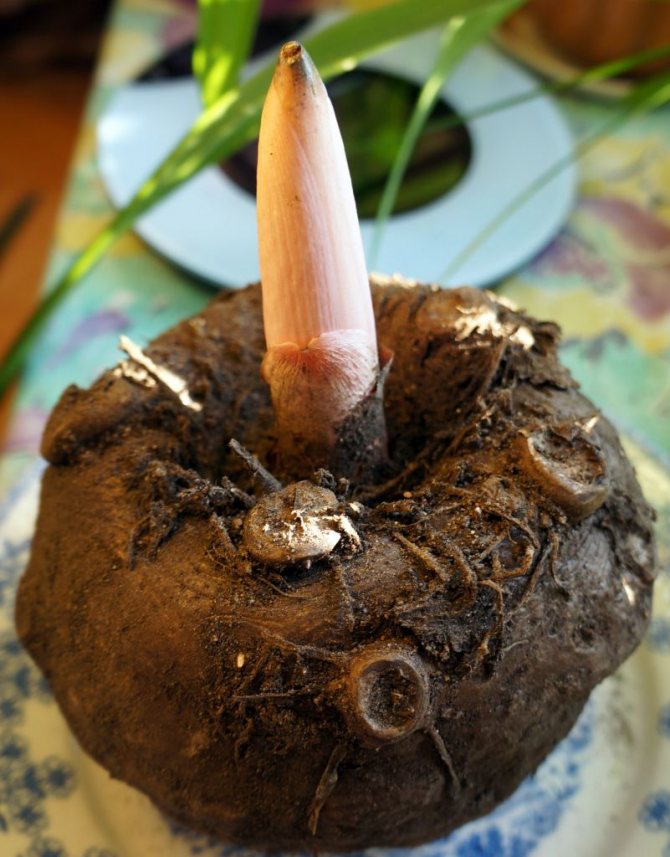

Amorphophallus tuber
On a note! Before fertilizing the soil, it should be watered abundantly.
Dormant period
Before the onset of the dormant period, all leaves of the plant fall off. With the onset of their wilting, feeding is stopped. For this period, it is recommended to rearrange the flower pot in a dark and cool place. Watering should be reduced to 1 time in 20 days.
At the end of March, flower growers recommend transplanting the tuber into a new larger container. Rotten spots on the tuber should be trimmed and cut with charcoal, then leave the tuber in the open air for a day. The plant can then be planted in fresh soil.
There is a second option for storing tubers - in a dark, cool place. After the leaves fall off, you should remove the tuber and clean it from the soil. If there are daughter processes, they are removed. If there are dead roots and rotten areas, they are cut off, then the cuts are treated with a solution of potassium permanganate.After the tubers are stored in a dry, dark place.
Transfer
Amorphophallus is transplanted annually. The procedure is carried out in early spring, when a sprout begins to appear at the point of growth. The ideal container should be 2-3 times the size of the tuber itself. It is recommended to use a heavier pot - better made of ceramic. The transplant procedure includes the following steps:
- a mixture of coarse sand, crushed brick and expanded clay is poured onto the bottom of the pot;
- a disinfected substrate is poured on top;
- examine the tubers - they should not have rotted areas; damaged areas are cut with a knife and treated with crushed chalk, activated carbon or iodine; allow to dry for about 3 hours;
- in the prepared soil, a notch is made and sand is poured there, the bottom of the tuber is lowered into it by 1/3;
- add soil around the edges and shake the pot; the growth point must remain on the surface;
- after planting, the tuber is watered, but not abundantly;
- during the active development of the plant, the soil must be gradually filled up.
It should be borne in mind that the daughter tubers are formed in the upper part of the mother.
Transfer
Description of amorphophallus
Amorphophallus (Amorphophallus) is a genus of very unusual plants of the Aroid or Aronnikov family. Most of them are endemic, that is, they have a clear habitat.
In nature, the plant prefers flat terrain and tropical or subtropical climates. It is found in West Africa, Asia, Australia, the islands of the Pacific and Indian oceans. Most species are found in Indochina.
The name of the flower is a combination of two Greek words that describe the appearance of the inflorescence: amorphos (amorphous, shapeless) - due to the lack of clear contours on the ear, resembling a swollen candle, and phallos (phallus) - due to inevitable associations with a certain part of the male body ... Amorphophallus's amazing appearance and specific odor has provided several unpleasant nicknames. At home it is called "damn" or "cadaverous flower", "devilish language" "Voodoo lily", "snake palm".
Fresh articles for gardeners, gardeners and florists
Pruning cherries in autumn for beginners in pictures step by step
What to plant after tomatoes next year
What to plant after strawberries in autumn
Planting garlic in autumn before winter in Siberia
The genus has more than 150 representatives. Sizes range from tiny to huge. In most amorphophallus, the aerial part dies off before the dormant period, but there are also evergreen varieties.
The root system of the plant is a tuber. At the top there is a growing point, from which one leaf emerges (very rarely - 2-3) with a height of 1-3 m. At the end of the growing season, it dies off, at the end of the dormant period a new one appears, slightly higher than the previous one and deeper dissected along the edges.
A single inflorescence appears earlier than the leaf. The flowering period is short - 10-15 days. During this time, the tuber noticeably decreases in size, since the giant flower requires appropriate nutrition.
At home, the flowering of amorphophallus grown from seeds will have to wait at least 7–10 years, and a plant obtained from a tuber - 5–7 years.
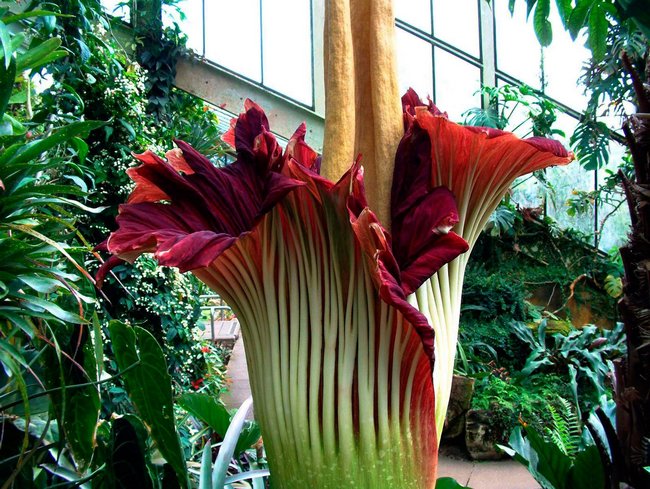

Benefit and harm
Amorphophallus perfectly neutralizes toxins, benzenes, phenols and formaldehydes, staphylococci, viruses and harmful bacteria. Staying near this plant is beneficial for those suffering from heart disease, intestinal cramps, and biliary tract problems. Sedative and anti-stress substances are released into the atmosphere from its leaves.
In home floriculture, this original plant is rare. In one year, from an exotic flower, it gradually turns into an umbrella-shaped tree, resembling a palm tree, and then into a tuber-potato.

